Abstract
Spanish has two forms to introduce comparative standards: que ‘that’ and de ‘of.’ The comparative morpheme is always the same más ‘-er/more.’ While que-comparatives show no variation in their syntactic properties, there is significant variation within de-comparatives regarding extraposition, scope, ACD resolution and the syntax of comparative numerals. Despite this variation, I argue that a uniform account is possible. I propose that más has the same syntax across the board (i.e. it takes the late-merged standard as complement, Bhatt and Pancheva 2004) and semantically it is a generalized quantifier over degrees (Heim 2001). The analysis (i) ensures that más and the standard form a constituent, (ii) allows for inverse scope, ACD resolution inside the standard of comparison and extraposition.
Similar content being viewed by others
1 Introduction
There is a great amount of variation in the expression of comparative constructions cross-linguistically. A common strategy is to morpho-syntactically differentiate the comparative morpheme, i.e. -er/more, from the standard morpheme, i.e. than (Stassen 1985; Beck et al. 2009). One such a language is Spanish where the standard of comparison can be introduced by two distinct morphemes: que ‘that’ and de ‘of.’ The comparative morpheme, however, remains always invariant: más ‘-er/more’ for superiority and menos ‘less’ for inferiority. This is illustrated in (1):Footnote 1Footnote 2
-
(1)

The choice of either que or de is not arbitrary but is conditioned by a series of syntactic and semantic factors (Price 1990; Brucart 2003; Mendia 2020). Que is a complementizer that selects for TPs; thus, it introduces clausal complements. This is supported by the fact that multiple constituents can co-occur inside the standard where comparative ellipsis has occurred (Bresnan 1973; Lechner 2001, 2004, 2020; Bhatt and Takahashi 2011; a.o.). On the contrary, de is a preposition and its complement must be a nominal. As a result, it is impossible to have multiple (indepdendent) constituents co-occurring inside the de-standard. This contrast is given in (2).Footnote 3
-
(2)
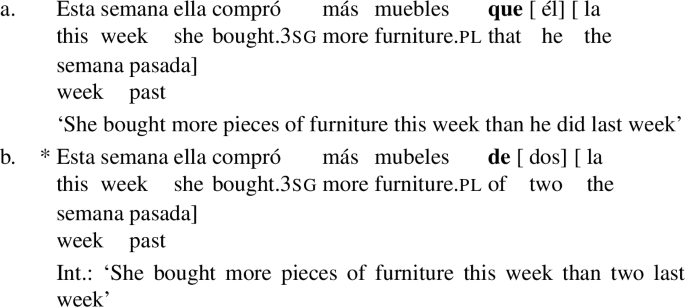
With respect to the semantics, clausal standards have been argued to involve degree-abstraction (Bresnan 1973; Heim 2001; Pancheva 2006; Beck et al. 2009), which makes them behave as predicates of degrees. The remnant constituents themselves inside the standard, though, can denote properties. This differs from de-standards which lack degree abstraction; and, the nominal complement that they introduce has to be degree-based. One way to test for this difference, as proposed by Mendia (2020), is to use the non-agreeing demonstrative pronoun eso ‘that,’ which can either make reference to an individual or to a degree. This difference is shown in (3) and (4):Footnote 4eso in (3) is making anaphoric reference to a degree (i.e. the age of the skirt); eso in (4) is referencing an individual, i.e. the tee.
-
(3)

-
(4)
[I have an old tee and an older skirt. Pointing at the tee.]

Furthermore, de is rather selective when it acts as the standard morpheme. In particular, the DP that de introduces may consist of a numeral or numerically modified NP as in (1b); a non-agreeing demonstrative pronoun making reference to degrees like in (3); or a free relative as in (5).Footnote 5
-
(5)

Free relatives fit the pattern of complements selected by de given that (i) they are DPs introduced by a definite or quantity determiner and (ii) are definite degree descriptions (Izvorski 1996; Donati 1997; Caponigro 2004; Gutiérrez-Rexach 2014). As a result, they are incompatible with standard morpheme que, e.g. (6).
-
(6)

The generalizations that emerge from this discussion can be summarized in (7), slightly modified from Mendia (2020):
-
(7)

A question that (7) raises is whether a uniform analysis of the two types of comparatives is possible, considering that the standards of comparison they introduce belong to different syntactic categories, and are of a distinct semantic type. One possible answer is that such uniformity is not feasible (Mendia 2020). In this paper, I argue that not only is uniformity a more parsimonious and desired alternative but it is also empirically supported. In particular, I argue that it can be achieved by making the following two proposals:
-
(8)

(8a) provides a uniform treatment for the comparative morpheme as a generalized quantifier over degrees, which has been independently argued for (Heim 2001; Bhatt and Pancheva 2004; Pancheva 2006, 2010; Lechner 2020; a.o.); and (8b) enables it (Pancheva 2006, 2010). This aligns with the cross-linguistic observations made by Pancheva (2006), Bale (2008) and Alrenga et al. (2012) that the semantics of comparison is not only encoded by the degree quantifier, but also by the standard morpheme. In fact, as they argue, in those languages that mark the phrasal vs. clausal distinction, the difference lies in the standard morpheme and not in the comparative morpheme.Footnote 6
The goal of this paper is twofold: (i) to provide a uniform syntactic analysis of comparatives in Spanish; and, (ii) to provide a full compositional semantic analysis with unified semantics for más and a semantic role for the standard morphemes. In a nutshell, I propose that, instead of being ambiguous, más should be analyzed as a Degree head that must undergo an operation of Quantifier Raising (QR) to a higher node (Heim 2001), at which point the standard is late-merged as its sister (Bhatt and Pancheva 2004). In addition, I compare the findings and predictions that the uniform analysis makes with the ones made by the non-uniform account developed in Mendia (2020). The two analyses are largely the same regarding que-comparatives, but they differ with respect to de-comparatives. I show that the non-uniform analysis faces a series of challenges that the uniform analysis does not.
The paper is organized as follows. In Sect. 2 I describe the core data for the two types of comparatives. I start to develop my proposal and delve into the details of the analysis in Sect. 3. In Sect. 4, I address the locality and height of QR, and the interactions with Scope Economy. In Sect. 5, I compare my analysis with Mendia’s (2020), and in Sect. 6 I address the Spanish data and some related cross-linguistic variation. Finally, Sect. 7 concludes the paper.
2 Core data
I first focus on que-comparatives (Sect. 2.1) and then move on to de-comparatives (Sect. 2.2). At this point I devote a subsection to discussing the relevant data for the subsequent analysis (e.g. comparative numerals, Sect. 2.2.1; extraposition into the clause, Sect. 2.2.2; inverse scope, Sect. 2.2.3; and ellipsis and ACD, Sect. 2.2.4). I then summarize the main findings in Sect. 2.3.
2.1 Que-comparatives
Spanish has a clausal comparative strategy which involves the comparative morpheme más and the standard morpheme que. I will refer to these as que-comparatives. One of the properties of que-comparatives is that the standard of comparison can appear extraposed into the clause. This is shown in (9):Footnote 7
-
(9)
Que-extraposition into the clause

In (9), the standard que un iPhone ‘than an iPhone’ may occupy different positions: it may precede both clausal adjuncts or appear to the right of either of them. Comparative ellipsis has applied to the embedded clause deleting everything but the remnant.
Relatedly, que-comparatives give rise to ambiguities depending on the size of the elided constituent. For example, the sentence in (10) is ambiguous between the two interpretations in (10a) and (10b).
-
(10)

The ellipsis site in (10a) is resolved by copying the non-finite clause trabjar arduamente ‘work hard,’ and what is being compared are the speaker’s working habits and the speaker’s boss’ working habits. In (10b), the ellipsis site is larger: it contains the matrix clause embedding the non-finite one. An accurate paraphrase is “my father tells me to work this hard and my boss tells me to work that hard”: this > that.
In addition to the extraposition and ellipsis resolution facts, it has been observed that comparative morphemes may take inverse scope over some quantificational elements, namely modals (e.g. Heim 2001; Bhatt and Pancheva 2004; Beck et al. 2009). Based on these observations, Mendia (2020) notes that the comparative morpheme más can also take inverse scope over intensional operators when the standard of comparison is introduced by que. This is shown with menos in (11).Footnote 8
-
(11)

The surface scope interpretation is a comparison of maxima: the maximal height of Juan’s jump and the maximal height of Pedro’s jump. The modal is imposing the requirement that the maximal height of Pedro’s jump cannot exceed the maximal height of Juan’s. However, the inverse scope is merely saying that Pedro is not required to jump as high as Juan, but he may do so. Both interpretations are acceptable in Spanish.
Ellipsis resolution, scope and surface position of the standard of comparison have been argued to be governed by the same underlying mechanism. In fact, as observed first by Sag (1976), Williams (1974, 1977) and subsequently by Bhatt and Pancheva (2004), there is a correlation between the size of the ellipsis and scope of the DegP. This generalization is known as the Ellipsis-Scope Generalization, formulated as in (12).
-
(12)
The Ellipsis-Scope Generalization
The scope of a DegP containing elided material must contain the antecedent of the ellipsis.
2.2 De-comparatives
In addition to que, the standard of comparison can also be introduced by the preposition de. I will refer to these as de-comparatives. An immediate question is whether más…de comparatives exhibit the same syntactic properties as their que counterparts. I will show that, while they do, there are important differences between the two types of comparative constructions. This variation seemingly questions a uniform analysis.
2.2.1 Comparative numerals
Nominal comparatives that have a numeral/numerically modified noun inside the standard are referred to in the literature as comparative numerals (Arregi 2013). One of the hallmark properties of de-comparatives is that numerals or numerically modified nouns can appear inside the standard. An example taken from Brucart (2003: p. 44, ex. 55a–b) is given in (13):
-
(13)

The sentences in (13) are truth-conditionally equivalent: ‘the number of books that I bought is bigger than 2’; but they differ on the surface depending on whether the NP libros ‘books’ is immediately adjacent to the numeral in (13a) or immediately adjacent to más in (13b).
Comparative numerals with de raise questions about DP-internal constituency, as well as the relation between más and the standard. In particular, what is the underlying structure of comparative numerals? And, are there two separate NPs underlyingly or just one? In order to provide a complete analysis of comparative constructions, and more specifically de-comparatives we must make headway in our understanding of comparative numerals.
2.2.2 Extraposition into the clause
The second set of challenging data is concerned with extraposition. Namely, extraposition of de-standards into the clause is not acceptable when the complement of de is a numeral/numerically modified NP or a degree-denoting pronoun. This is shown in (14):
-
(14)
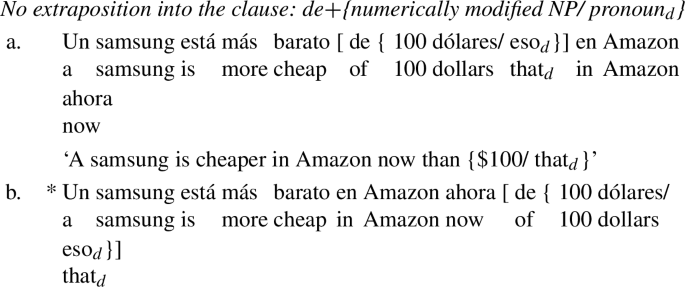
While it is true that the ungrammaticality of (14) is indisputable, we should not generalize that all de-standards cannot appear extraposed into the clause. In fact, there is a subset of de-standards that can. These include free relatives, both full (16a) and reduced (16b–16c).Footnote 9 By reduced free relatives I refer to those free relative constructions that lack an overt verbal projection. They typically consist of a definite determiner and a predicate, as in (15):
-
(15)
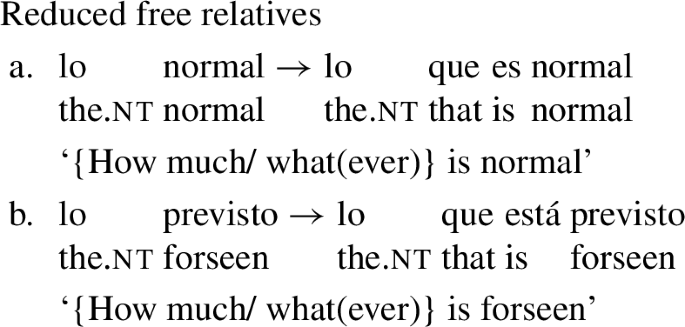
-
(16)
Extraposition into the clause: Full & reduced free relatives
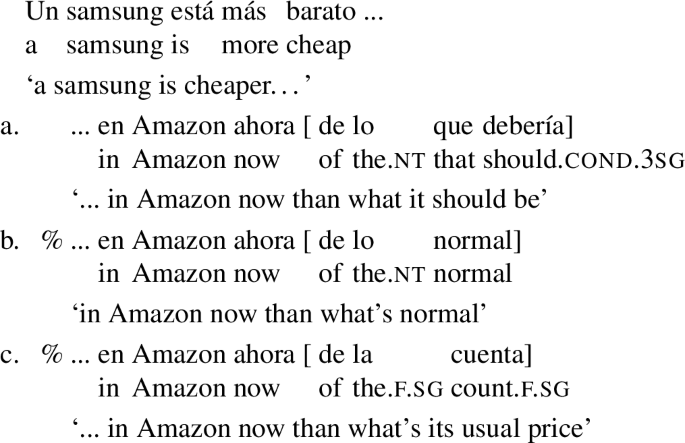
The examples in (16) show that extraposition is not limited to que-comparatives (contra Mendia 2020); de-standards may appear extraposed into the clause as well. The data, in fact, suggest the generalization in (17):Footnote 10
-
(17)

The generalization prohibits extraposition into the clause of (14) since the standard is composed of a numerically modified NP or a degree-denoting pronoun; but crucially it does not rule out (16) with a free relative. We must then explain what restricts the two types of más…de discontinuity.Footnote 11
2.2.3 Inverse scope
A third challenge is the variation in inverse scope. Mendia (2020) has reported, based on data like (18)–(19), that inverse scope between the degree morpheme and a modal is not possible when the standard is introduced by de. The data and the judgments are Mendia’s:
-
(18)
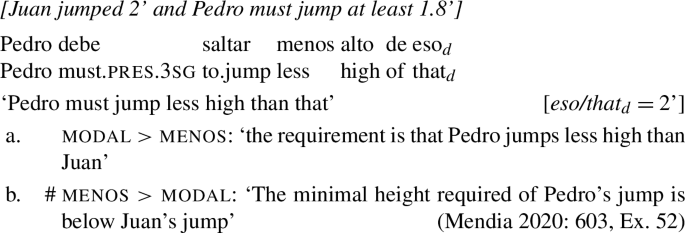
-
(19)

(18) and (19) do not allow the inverse scope interpretation with the lower bound. On the face of data like these, Mendia (2020) concludes that más does not interact with modals for scope when the standard is introduced by de.
However, this is not entirely accurate and the judgments are more nuanced than what has been originally reported. In particular, there is a split between standards that are ruled out by DEG and those that are not. In other words, no speaker consulted ever accepts the inverse scope when de introduces numerically-modified phrases or degree-denoting pronouns; but some speakers do accept más to scope over modals when the de-standard hosts free relatives.Footnote 12
Consider the example in (20) based on Heim’s (2006) driving scenario. The two possible readings are in (a) and (b).
-
(20)
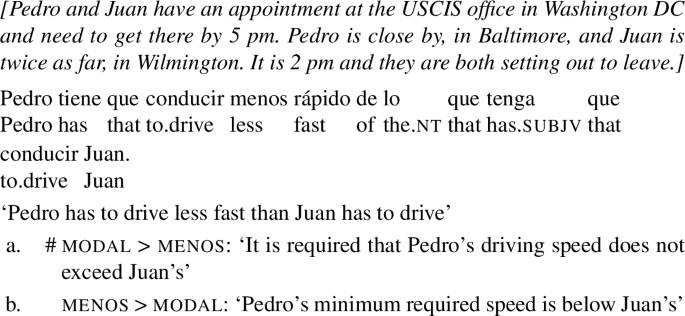
The standard denotes the maximal degree to which Juan has to drive, e.g. 100 km/h. Given the context, the sentence in (20) expresses the intuition that Pedro needs to drive less fast because the distance he has to cover is smaller in the same amount of time. In this scenario, the sentence is false under the interpretation where it is disallowed for Pedro to drive faster than Juan. Crucially, however, the sentence is true under the interpretation that Juan’s driving speed is higher than Pedro’s but it is acceptable for Pedro to drive faster than him; it is just that Juan’s minimum required speed is above Pedro’s. This interpretation is obtained by less taking inverse scope over the modal.
Similar scope facts are obtained with exactly differentials. This is illustrated in (21) which is ambiguous between Pedro having read exactly 5 books and Pedro having read at least 5 books. Both interpretations are acceptable.
-
(21)
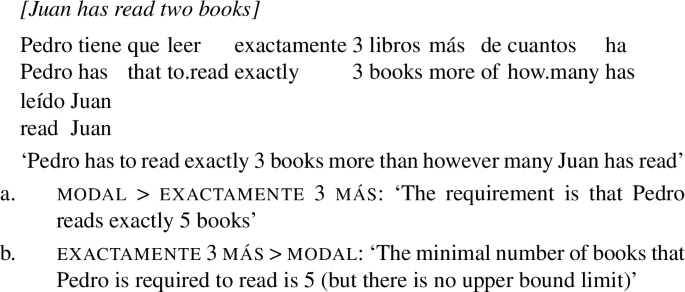
Regarding reduced free relatives such as (15), there is speaker variation as observed for extraposition into the clause and the size of the ellipsis site. In fact, I show in the next section that this variation in the acceptability of inverse scope correlates with the size of the ellipsis antecedent. The relevant data is in (22). We can make use of the same context for (22) as in (20) and assume that lo normal ‘the.nt normal’ = 100 km/h—which is Juan’s maximal speed in (20).Footnote 13
-
(22)

-
(23)
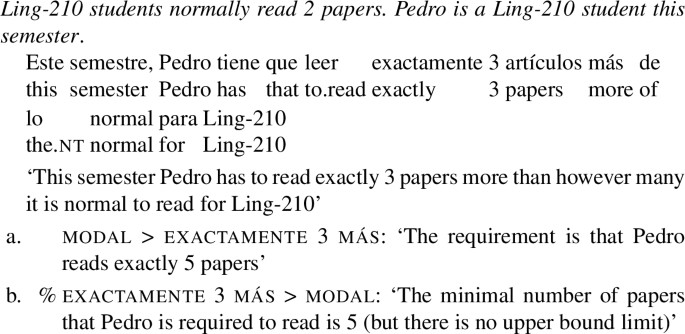
These examples contribute to the claim that the comparative morpheme in de-comparatives can also scope over intensional predicates.
2.2.4 Ellipsis and ACD resolution
In (12), I introduced the Ellipsis-Scope generalization which correlated the position of the DegP (by means of the standard of comparison) with the resolution of an ellipsis site. The generalization is also active in de-comparatives where the nominals inside the de-standard may also contain an ellipsis site. This is more clearly seen when the complement of de is a free relative as in (24).
-
(24)

(24) is a special case of ellipsis, namely Antecedent Contained Deletion (ACD) (May 1985) that involves a modal verb or an intensional predicate (Sáez del Álamo 1987).Footnote 14
The Ellipsis-Scope generalization cannot be illustrated with a typical English example involving VP-ellipsis like (25), due to the unavailability of VP ellipsis in Spanish (Saab 2007; Ranero 2021). We can test for ACD using verbs that allow for null complements, as in (24). But that might bring the additional complication that some verbs allow for both a finite and a non-finite complement. Of special interest are cases with the verb pensar which is lexically ambiguous between ‘to think’ and ‘to plan to/want to become.’ For example (26) is multiple-ways ambiguous:
-
(25)

-
(26)

The 4 possible interpretations are the result of resolving the ACD site of the verb pensar with the meaning of ‘to think.’ When pensar has this meaning it requires that its clausal complement be finite: the embedded clause in (26a) and (26c), and the matrix clause including the subject in (26b) and (26d).Footnote 15
In addition to the 4-way ambiguity, the verb pensar with the meaning of ‘to plan to/ want to become’ imposes a different selectional requirement on the clausal complement that it embeds: it must be non finite. When this is the case, it induces an additional interpretation.Footnote 16 As a result, this gives rise to a fifth possible interpretation of the sentence in (26).This is illustrated in (27):
-
(27)

In addition to full free relatives, reduced free relatives also contain an ACD site that needs to be resolved. The size of the ACD site might vary across speakers just like in the case of scopal interactions. For example, in (28), some speakers of Peninsular Spanish accept both a larger and smaller site, whereas others only accept a smaller option.Footnote 17
-
(28)
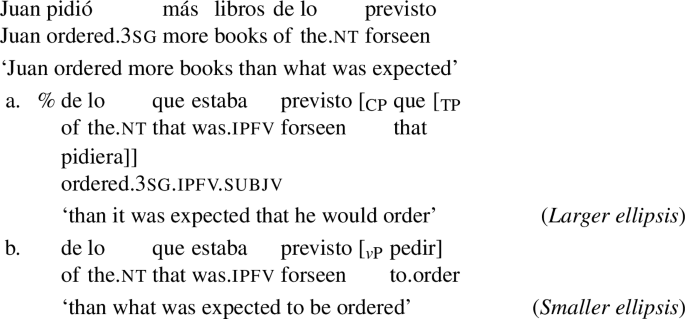
The consulted speakers all accept to resolve the ellipsis site with a non-finite verb phrase, i.e. vP. For some speakers it is also possible to resolve it by finding a larger antecedent that contains the external argument Juan as well as tense and aspect morphology on the verb, i.e. TP.
2.3 Interim summary
I have described the major properties of Spanish comparative constructions with que and de standards. I have shown that the properties of más across the two constructions are identical to a large extent: surface extraposition, ellipsis resolution and scope are possible with both types of comparative constructions. These properties are summarized in Table 1 for que and de-comparatives.
Concentrating solely on de-comparatives, however, we have observed that there is some variation depending on the constituent hosted by the standard. According to Table 1, the preliminary generalization that emerges is that there is a major split within de-comparatives: (i) comparative numerals and degree-denoting eso, (ii) and free relatives. On the one hand, comparative numerals and degree-denoting eso do not extrapose into the clause, and neither do they contain ACD sites or allow inverse scope. On the other hand, free relatives do. Additionally, there are fine-grained differences between the class of free relatives across speakers. While full free relatives always allow inverse scope and the ACD site to be large (i.e. at least a TP), reduced free relatives may not. Only if a speaker accepts inverse scope would they also accept a larger ACD site (and viceversa); but if they did not accept the former they would not accept the latter either (and viceversa).
It has been independently argued that extraposition, scope and ACD resolution can be accounted for if the constituent in question is a generalized quantifier (May 1985; Fox 1999, 2000, 2001, 2002; Fox and Nissenbaum 1999; Heim 2001; Bhatt and Pancheva 2004; Hackl et al. 2012). Thus, it would not be unreasonable to consider más to be quantificational. An appropriate analysis, though, needs to maintain a large degree of syntactic and semantic uniformity for más across constructions, while being flexible enough to capture the variation in Table 1. In the following sections, I argue that this can all be accomplished if más, which always takes the late-merged standard of comparison as its complement, is a generalized quantifier over degrees.
3 Towards a uniform analysis
3.1 Spelling out the assumptions
I am adopting the “classical analysis” of comparatives (Bresnan 1973; Hackl 2000; Heim 2001) according to which the comparative morpheme and the standard of comparison form a syntactic constituent to the exclusion of the gradable predicate. Schematically, the syntactic structure under the classical analysis is shown in (29):
-
(29)
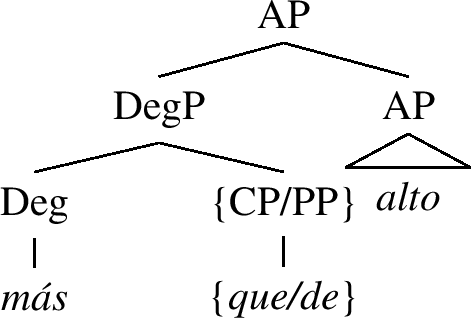
Under this view, más is a Degree head that takes the standard as its complement and projects a DegP which is in a specifier position of the phrase it modifies.Footnote 18
However, I follow the particular implementation proposed by Bhatt and Pancheva (2004): the head-complement relation between the comparative morpheme and the standard is obtained derivationally. Building on Fox and Nissenbaum (1999) and Fox (2000), Bhatt and Pancheva (2004) argue that more/-er undergoes QR and right-adjoins to a scope position; the standard of comparison is late-merged as the complement of the QR-ed comparative morpheme. As a result, the standard of comparison is late-merged in its surface position.
In Sect. 2 we observed that más could take inverse scope over intensional verbs such as modals. According to Heim (2001, 2006) and Bhatt and Pancheva (2004), this is obtained by moving a quantificational element to a position above the modal triggering degree abstraction at the Logical Form (LF) level of representation. Quantifier raising has also been argued to be involved in surface extraposition phenomena (e.g. Fox and Nissenbaum 1999) and ACD resolution (e.g. May 1985; Wilder 1997; Bhatt and Pancheva 2004; Hackl et al. 2012). That said, a quantificational treatment of Spanish más, on a par with English more/-er, seems empirically appropriate.
Applied to Spanish, Bhatt and Pancheva’s “classical analysis” entails the following: más will merge in its base position, i.e. the specifier of some phrase; being quantificational, it will then undergo QR leaving behind a copy, and will adjoin to a scope position to the right; the standard of comparison, regardless of whether it is phrasal (i.e. de) or clausal (i.e. que), late-merges as the complement of más in its QR-ed position. Más will then be interpreted in its scope position, but will be spelled-out in its base position. Schematically the steps of the derivation are given in (30):
-
(30)
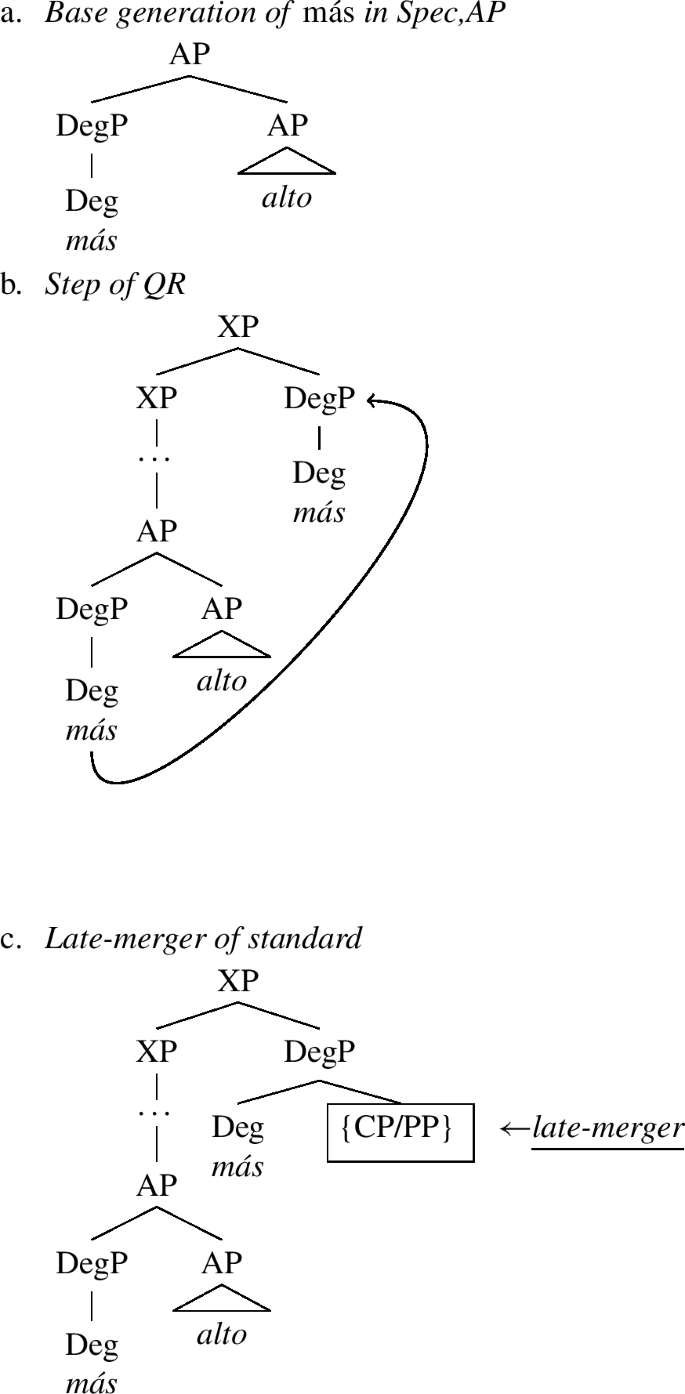
In terms of the semantics, I propose that más is a generalized quantifier over degrees of type 〈〈dt〉,〈dt,t〉〉 across the board. This is the only meaning for the comparative morpheme and its denotation is given in (31), taken from Heim (2001). Additionally, I propose that the standard morpheme is not vacuous and que has the denotation in (32).
-
(31)
\([\!\![\text{m\'{a}s} ]\!\!]=\lambda P_{\langle dt\rangle}.\lambda Q_{\langle dt\rangle}.[\textsc{max}(Q) > \textsc{max}(P)]\)
-
(32)
\([\!\![\text{que}_{\textsc{deg}} ]\!\!]= \lambda D_{\langle dt\rangle}.\lambda d. [\textsc{max}(D) \geq d]\)
Following Pancheva’s (2006) analysis of comparative and standard markers in Slavic languages, where we also observe a clausal vs. phrasal distinction, I treat que along the lines of a pseudo-partitive preposition: que will take a set of degrees as its first argument, and will return another set of degrees.Footnote 19
Más takes two arguments which are sets of degrees: the late-merged standard and the constituent in its scope after QR. I am assuming, following Heim and Kratzer (1998), that, after QR, más leaves a variable of type d in its base position. The variable is bound by a λ-abstractor created as a result of movement of más. The same operation of degree-abstraction holds in the clause inside the standard (Heim 2001).
The tree in (34) illustrates the derivation of the sentence in (33) where más has QR-ed and adjoined to the right. I assume that the copula in T is an identity function.
-
(33)

-
(34)
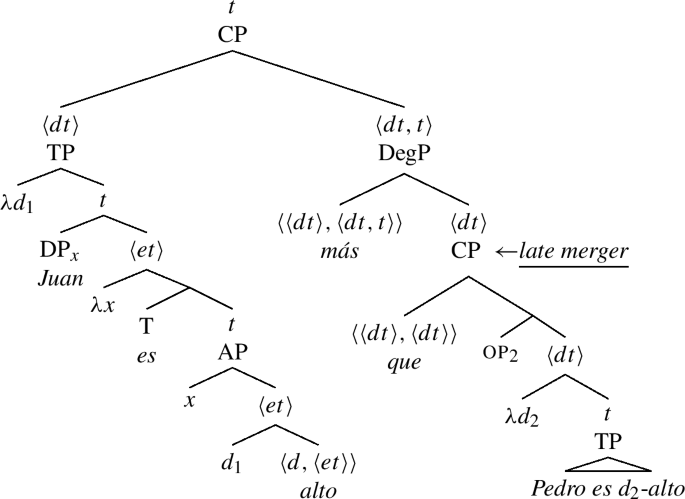
As the structure in (34) shows, más undergoes QR to a higher node (i.e. the matrix TP), which is of type t leaving behind a trace of type d in the base position. The gradable adjective alto ‘tall’ then takes the degree variable as an argument.Footnote 20 QR of más creates a λ-abstractor which binds the degree variable inside the AP and composes with its sister node of type t via Predicate Abstraction (Heim and Kratzer 1998). Predicate Abstraction returns a set of degrees of type 〈dt〉 which serves as the second argument for más.
Que-comparatives will follow this same pattern regardless of the syntactic category being compared (i.e. NP, AP, VP etc.) and the remnant inside the standard. We can thus generalize the derivation in (34) to every case of canonical clausal comparatives. The only difference will be that the longer the QR, the higher in the structure the standard of comparison will be late-merged. As a result, the surface position of the que-clause marks the exact scope of más capturing, among other things, the Ellipsis-Scope Generalization in (12).
The real challenge to the uniform analysis of comparatives is presented by the variation observed in de-comparatives. While—as shown in the introduction and argued by Mendia (2020)—the constituent inside the standard denotes a degree rather than a set of degrees, according to DEG in (17) and Table 1, standards containing numerals and degree-denoting pronouns have different properties than free relatives.
In order to make any headway in our understanding of these constructions, we must first analyze the underlying syntactic structure of these comparative numerals. In the next subsection, I focus on them. I propose an analysis of comparative numerals along the lines of Bhatt and Homer’s (2019) analysis of differential comparatives. This has the welcome result of unifying differential MP constructions and numerically modified NPs within de-standards. In addition, the arguments and data in the next section will allow us to understand the facts captured by the DEG in (17), and will add a motivation for local QR: NP-ellipsis resolution.
3.2 The syntax of comparative numerals
Comparative numerals like (13), repeated below as in (35), pose some challenges to the QR analysis of comparatives. As I noted, the sentences are truth-conditionally equivalent. And yet, the word orders differ: más and the standard are not (linearly) separated from each other in (35a) while they are on the surface in (35b). This is specially puzzling under a QR analysis because (i) the high copy of más that is a sister to the standard is generally deleted, and (ii) the standard cannot appear extraposed into the clause.
-
(35)
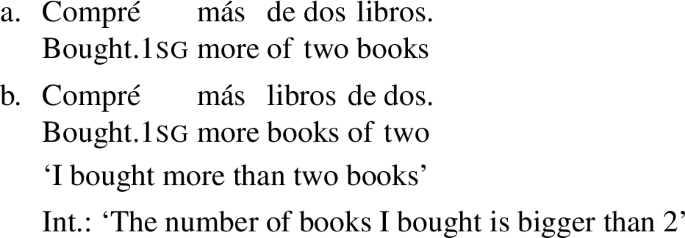
Based on cross-linguistic data from comparative numerals, Arregi (2013) argues that the degree head and the standard of comparison must form a constituent. Arregi, who is not concerned with issues of QR and extraposition of the standard, captures that dependency with the structure in (36):
-
(36)

I take Arregi’s (2013) insights about the relationship between más and de to be correct. Building on Arregi (2013) though, I propose that comparative numerals like (35) consist of two identical NPs: one inside the standard and another outside of it. The former is the one directly modified by the numeral, and the latter is part of the extended projection of the matrix DP. Either NP may or may not be overt. The finer-grained structure of comparative numerals is schematically represented in (37), ignoring extraposition for the moment, where the DegP occupies a specifier position in the extended projection of the standard-external NP:
-
(37)
[NumP [DegP [Deg’ más [PP de [DP # Num NP1]]]] [Num’ Num NP2]]
A crucial consequence of this structure, which was already anticipated in (36), is that the complement of de cannot be the numeral alone, it must be the numeral and the noun it modifies. In what follows, I provide empirical motivations for the structure in (37).
3.2.1 Motivating the syntax
Class marker deletion & number mismatches under ellipsis in Spanish.
Arregi (2013) observes that the class marker (cm) of the numeral uno ‘one,’ i.e. the vowel -o, is deleted when the numeral is in a local relationship with the noun being modified.Footnote 21 However, the class marker is retained if the NP is deleted. This contrast is given in (38):
-
(38)
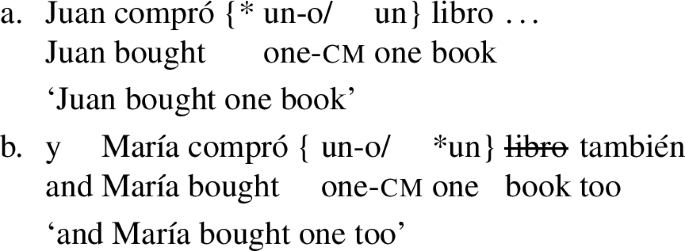
If comparative numerals involve NP-ellipsis, we should expect the same patterns of class marker-deletion/retention. This is borne out as shown in (39):
-
(39)

When the NP directly modified by the numeral inside the standard is overt, the class marker on the numeral is deleted. However, if only the standard-external NP is overt, the class marker is retained.
In addition to class marker deletion, Spanish allows the antecedent NP and the elided NP to mismatch in number (Picallo 2008; Lipták and Saab 2014). This is shown in (40) from Lipták and Saab (2014: p. 9) where the antecedent NP libros in the first conjunct is plural but the elided NP in the second conjunct is singular.
-
(40)

If the comparative numeral constructions under discussion involve NP-ellipsis, the same mismatches between standard-internal and standard-external NPs are expected. That is precisely the case of (39). The NP can be overt or deleted in either position (i.e. standard-internally or externally) without having a truth-conditional impact. In (39a) it is the standard-external NP that has been deleted and so is the class marker of uno, due to the numeral and the singular NP being in a local relationship. The standard-internal NP is overt and singular. In (39b), on the other hand, ellipsis has targeted the standard-internal NP: the numeral uno requires the NP it modifies to be singular. As a result of this NP being deleted, the class marker on the numeral is retained. In short, the sentences in (39) are underlyingly as in (41):Footnote 22
-
(41)

Furthermore, there is independent evidence from the countability restrictions imposed by degree morphemes that the singular libro, in (39a)/(41a), cannot be standard-external: it must form a constituent with the numeral un. Comparative morphemes and vague numerals (e.g English many, Spanish muchos/tantos) are incompatible with singular count NPs, but are compatible with plural count or mass NPs (Krifka 1989; Chierchia 1998; Hackl 2000; Schwarzschild 2006; Nakanishi 2007; a.o.).Footnote 23 Thus, if más was modifying the singular count NP, the sentence must be ungrammatical. Since it is not, and considering that number mismatches are allowed between antecedent and elided NP, más must be modifying a different NP, namely a plural count NP: libros. This rules out a bracketing like the one in (42):
-
(42)

Additional evidence: Number and class agreement in Bulgarian.
This is not an isolated accident from Spanish. In fact, similar facts obtain in Bulgarian. In Bulgarian the numeral ‘two’ inflects for gender: masculine dva vs. feminine/neuter dve. Masculine inanimate nouns have to appear in the “count” form (i.e. ct) with numerals, not the plural. The “count” morpheme is an adnumerative form, distinct from singular and plural (Ionin and Matushansky 2018: 199–204).Footnote 24 However, masculine inanimate nouns cannot appear in the “count” form with vague numeral ‘many’ and comparative poveče ‘more’; they have to appear in the plural form. This is shown in (43):
-
(43)
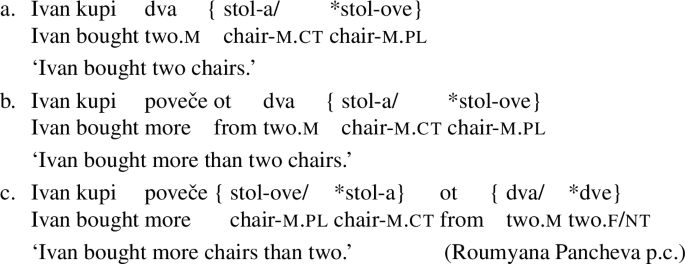
In the simple numeral construction in (43a), the noun ‘chair’ is masculine count, e.g. -a. The same is observed in the comparative numeral in (43b). This indicates that dva ‘two’ and the noun stol-a ‘chair-m.ct’ are in a local relationship. The agreement pattern changes when the comparative poveče stands in a local relationship with the noun ‘chair’ in (43c): ‘chair’ is masculine plural, e.g. -ove, instead of masculine count, e.g.-a. Importantly, in the Bulgarian counterpart of ‘more chairs than 2’ in (43c), the numeral is obligatorily masculine.
From (43c) we can conclude several things. First, there is an NP that is external to the DegP (NP2 in (37)) and is directly modified by the comparative morpheme. This is evidenced by the masculine plural agreement. Second, just like in (43b), the numeral ‘two’ surfaces with the masculine form, suggesting that there is an elided NP stol-a ‘chair-m.ct’ inside the standard that the numeral agrees with. The fact that there is NP ellipsis in the standard is independently supported by nominal ellipsis under a numeral. This is illustrated in (44).
-
(44)

The numeral ‘two’ retains the same masculine morpheme, e.g. -a, when the NP ‘chair’ has been deleted in the second sentence. In short, Bulgarian comparative numerals behave like Spanish.
Despite the fact that in no language, as far as we know, do we see the pattern more books than 2 books overtly where the NP books is repeated, there is evidence that there are actually two instances of the same NP: cm-deletion and number mismatches in Spanish, and count gender agreement in Bulgarian adnominative numerals. As a result, I propose that underlyingly there are two identical NPs, one inside the standard of comparison and another external to the DegP: either NP may then undergo deletion. Again ignoring extraposition for the moment, I propose that comparative numeral constructions have the syntax in (45)—for Spanish (39a) and Bulgarian (43b)—and in (46)—for Spanish (39b) and Bulgarian (43c):
-
(45)
more than one book
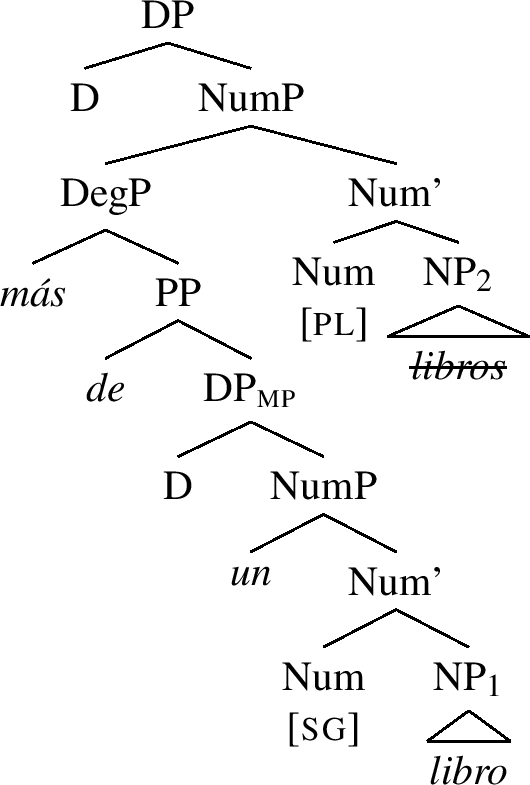
-
(46)
more books than one
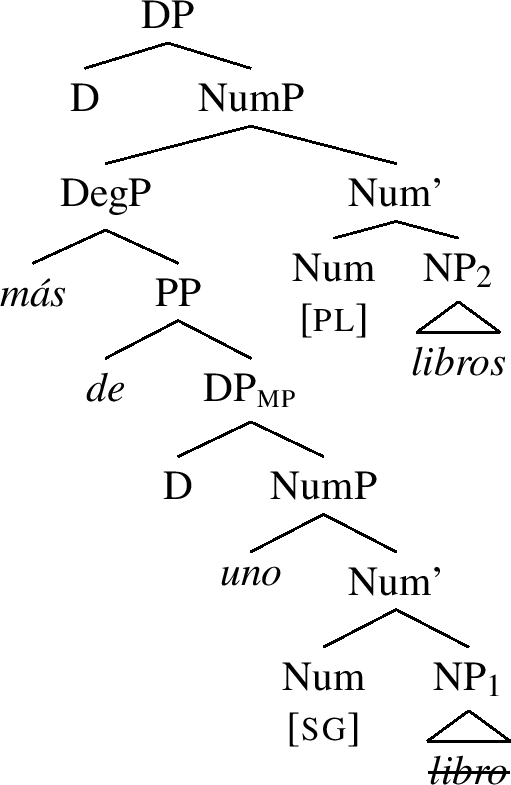
The structures capture the numeral agreement patterns and class maker syncope described above. Furthermore, an advantage of these structures is that the dimension of comparison is kept constant (e.g. cardinality of books), and need not be stipulated.Footnote 25
3.2.2 Deriving the word order patterns
The structures proposed above for comparative numerals, and in particular (46), look like a prima facie challenge to the surface word order observed for comparatives. If the structures were to remain as they are in (45) and (46), the DegP should be linearized to the left of NP2 libros; but this is not accurate because the standard of comparison does never surface in that position. This challenge is only apparent given that I am adopting Bhatt and Pancheva’s (2004) analysis of comparatives according to which más undergoes QR to the right (Fox and Nissenbaum 1999; Fox 2000). It is in this position where the standard of comparison is late-merged. This is illustrated in (47) for the structure in (46) where intermediate projections have been omitted for simplicity:
-
(47)
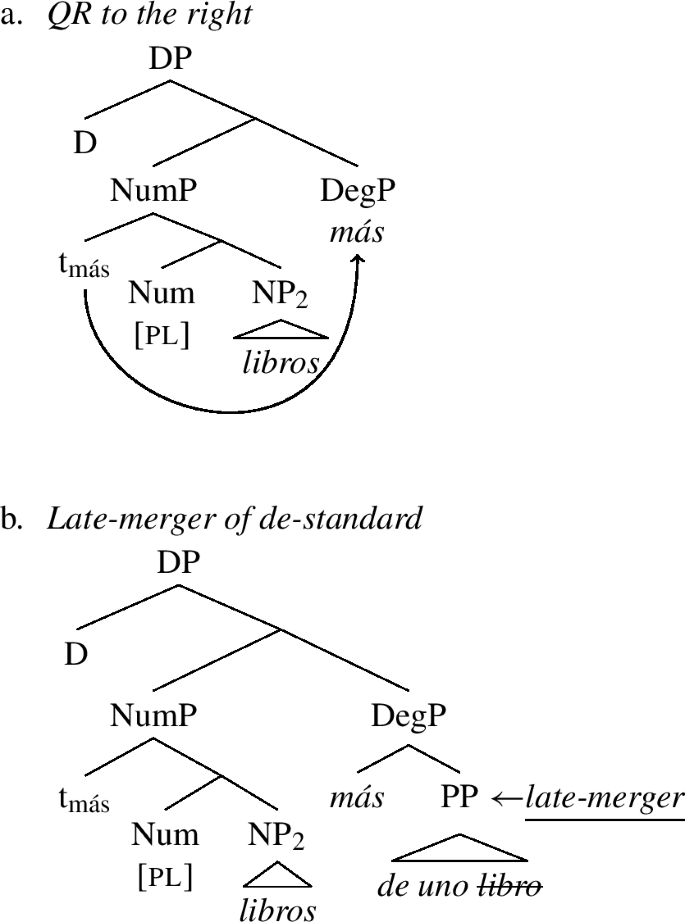
Under the Copy Theory of Movement (Chomsky 1995, Nunes 1995, et seq.), movement of más leaves a copy in its base position, i.e. Spec,NumP. The movement and late-merger of the standard take place before the structure is spelled-out and transferred to PF and LF. Once the structure is spelled-out, at PF there are two copies of the moved quantifier. Given the Phonological theory of QR (Bobaljik 1995b, 2002; Pesetsky 2000), the highest copy created via movement is deleted and the lowest one in Spec,NumP is spelled-out. There is only one copy of the standard of comparison, though, since it has been late-merged in the DegP’s final landing site. Furthermore, given the step of rightward QR, the standard will be linearized to the right of everything it c-commands (Nunes 1995, 2004; Uriagereka 1999; Fox and Pesetsky 2009; Davis 2023; a.o.).
The semantics that I assume for más in (31) (a generalized quantifier over degrees) forces it to QR to a scope position. This DP-internal scope position has been independently argued for in the domain of comparatives (Matushansky 2002) and superlatives (Heim 1999; Sharvit and Stateva 2002; Pancheva and Tomaszewicz 2012). The quantifier composes with the late-merged standard in this position. In addition to resolving the type mismatch, QR to the DP internal position feeds NP ellipsis resolution.
These same operations occur when the DegP external NP is elided instead. As shown in (48), más QR-s to the right leaving a copy in its base position; the standard is then late-merged in the final landing site of más. Despite the fact that surface order invites an analysis in which the standard of comparison is merged (and subsequently interpreted) in the base position of más, the syntactic and semantic evidence tells us otherwise.Footnote 26
-
(48)

3.2.3 Extending the analysis to de-standards with degree-denoting pronouns
De-standards containing degree-denoting pronouns are no different from the comparative numerals just discussed. Pronouns have been argued to be definite determiners whose complement has undergone ellipsis (Postal 1966; Elbourne 2001, 2005). Thus, despite the fact that there is a single exponent eso, pronominal de-standards have the syntax of a full DP whose D head has survived deletion. Thus, at LF that covert piece of structure must be interpreted. In other words, the underlying syntax of numerically modified NP standards and pronominal ones is identical, but the sentences differ with respect to their externalization at PF.
According to Elbourne (2001), there are two conditions that make the NP/NumP deletion rule possible: an overt linguistic antecedent, or the presence of deictic aid in the discourse. In a sentence like (49), it is the first condition that is met, whereas in (50) it is the second condition that is met:Footnote 27
-
(49)

-
(50)
[Juan is 1.75 m tall]

The underlying structures for (49) and (50) are given in the trees in (51) and (52) respectively, where the PP has also been late-merged:
-
(51)
Structure of (49)
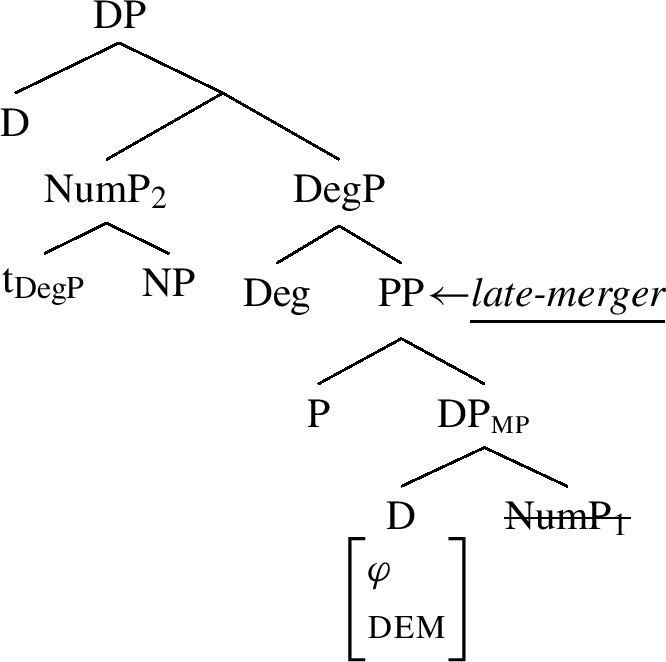
-
(52)
Structure of (50)
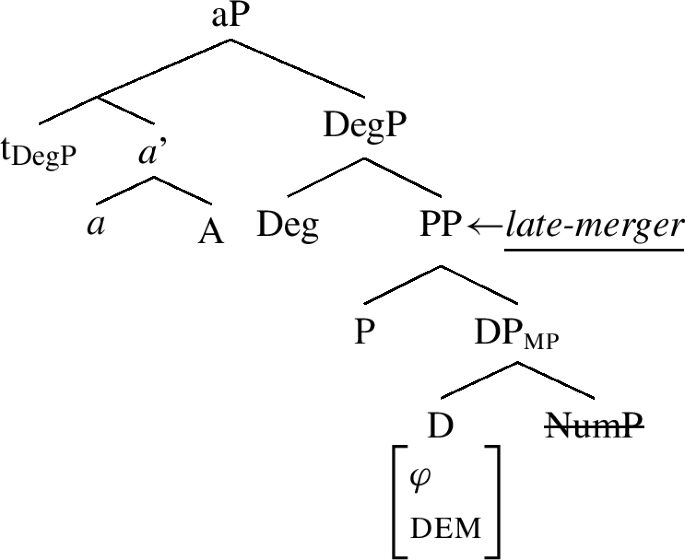
This has the desired result: at LF, the degree quantifier is adjoined to node of type t and the conditions for interpretation (in terms of cardinality or quantity) are met. At PF, D’s complement is deleted and rules of impoverishment taking place before Vocabulary Insertion (Arregi and Nevins 2012; Haugen and Siddiqi 2016) make sure that the correct exponent is inserted under the D node inside the standard.
3.2.4 Tacking stock
The underlying syntactic structure I have proposed does not only receive cross-linguistic empirical support, but it is also parsimonious. In both que and de-comparative, QR takes place. We achieve a parallelism between de-comparatives and que-comparatives with respect to QR. In addition to this, this structure has two extra benefits. First, we are able to explain Mendia’s (2020) observation that the dimension for comparison needs to be kept constant. This follows from the fact that the standard-external and standard-internal NPs are identical: if the NP is books, for example, we are comparing the degree of cardinality that n-books have to the degree of cardinality that n’-books have.
Second, we can draw a parallelism between differential Measure Phrase (MP) constructions and the complements of de-standards. As discussed by Bhatt and Homer (2019) and Homer and Bhatt (2020), differential nominal comparatives like 2 books more and 2 more books involve the presence of two NPs: the differential NP, and the NP that introduces the comparative in its specifier. One these NPs has to be covert. As they observe, the two NPs have to be identical for the dimension of measurement to be established along the relevant scale. This is exactly the situation we find in the nominal comparatives under discussion. Furthermore, the same numerically modified NPs that serve as complements of the de-standard can occur as differential arguments as well. This is shown in (53) where we can observe the same class marker deletion patterns as in (39).
-
(53)

Numerically modified NPs selected by de denote degrees, and so do the differentials (von Stechow 1984). Therefore, we can also extend Bhatt and Homer’s (2019) and Homer and Bhatt’s (2020) observation that nominal MPs are coextensive with the class of count nouns.
Considering the discussion in this section, we can now enlarge the generalization for de-comparatives in Table 1 as in Table 2. In fact, we can now take take these properties to diagnose the height and motivation of QR. QR with comparative numerals and degree-denoting pronouns has to occur locally because it is only driven by a type mismatch or by NP ellipsis.
In the next section, I provide a semantics for de. This semantics will allow más to take the late-merged standard of comparison as its first argument, after más has undergone QR.
3.3 A semantic role for de
We have observed how the lexical entry for más in (31) appropriately computes the meaning for clausal comparatives: the CP is of type 〈dt〉 as a result of operator movement in the syntax triggering degree abstraction at LF inside the standard. However, as is, más would fail to compose with phrasal comparatives. As I have shown following Mendia (2020), the semantic type of de’s complement is d, i.e. a degree. Thus, there is a type mismatch: más requires its first argument to be a set of degrees, but the standard of comparison denotes a degree.
I propose that we can solve this compositional issue if the preposition de itself is not semantically vacuous (von Stechow 1984; Rullmann 1995; Pancheva 2006; Alrenga et al. 2012). Instead de will take the standard of type d as its argument and return an element of the appropriate type to saturate the comparative morpheme’s first argument. The lexical entry for the preposition is given in (54):Footnote 28
-
(54)

De in (54) denotes a function from degrees d to sets of degrees 〈dt〉. What is more, the lexical entry in (54) reminds us of the meaning of the partitive preposition de in (55): it takes a definite description of a plural or mass individual \(x'\) (of type e), and returns a set of individuals (of type 〈et〉) who are part of \(x'\). Thus, this analysis follows Pancheva’s (2006) thesis that (i) there is a parallelism between the domain of degrees and that of individuals, and (ii) the behavior of -er/más and de is parallel to that of a quantifier and its partitive first argument.
-
(55)

The DP that is de’s complement will saturate de’s first argument. That DP constituent must denote a degree even if its N head is an ordinary sortal noun like libros. It has been observed that numerically modified NPs can be ambiguous between a property-based or a degree-based interpretation (Rett 2014; O’Connor and Biswas 2015; Snyder 2021). These NPs may not themselves be measure-NPs, but ordinary sortal ones like pizza or guest, as in (56) and (57) from Rett (2014). Their interpretation can be disambiguated via agreement: singular agreement generally correlates with the degree interpretation, whereas plural agreement typically correlates with the individual interpretation (Rothstein 2009).
-
(56)

-
(57)

Furthermore, we have already seen that these same sortal NPs can appear as differential arguments where their denotation must be degree-based (von Stechow 1984; Bhatt and Homer 2019; Homer and Bhatt 2020).Footnote 29 That said, I consider that the noun inside the standard must have the semantics similar to that of measure nouns (Krifka 1989; Rothstein 2009, 2017; Scontras 2013; Rett 2014; Ahn and Sauerland 2015). That is, in addition to being a predicate of individuals, the denotation of a noun like book, shirt etc. can be degree-based.
In order to capture this, I follow insights from Brasoveanu (2009), Rett (2014), Homer and Bhatt (2020) and Coppock (2022) and propose that the degree interpretation is derived from the individual-typed interpretation. In particular, I propose that there is a covert operator unit that relates the count NP to the numeral that modifies it. unit introduces a measure function that takes the NP, of type 〈et〉, and the numeral, of type n, and returns a degree of cardinality/volume/weight etc. on the noun-scale that corresponds to n. The denotation for unit is in (58), where σ is any assignment function and σ(μ) is the measure function that σ assigns to μ. The content of the measure function is resolved by what is being measured (cf. Wellwood 2015, 2019):
-
(58)

The degree-based denotation for a noun like libros in 2 libros is in (59). Given that we are measuring plurarlities of books, the value for μ is cardinality (for details, see Wellwood 2019; Cleani and Toquero-Pérez 2022).
-
(59)
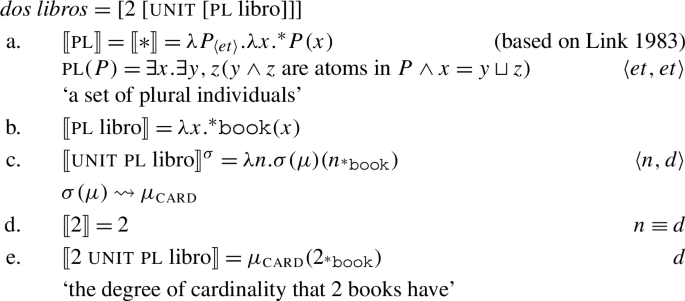
We can now derive the LF and semantic composition of de-comparatives. I do that for the sentence in (50) whose LF I represent in (60). The two arguments of más are boxed.
-
(60)
María is taller than that. [that = 1.75 m]
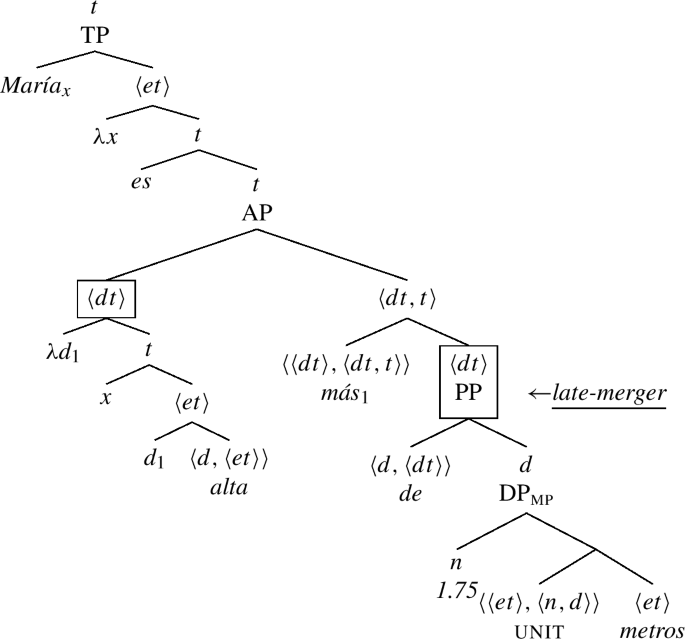
First más undergoes QR to a scope position and then the de-standard is late-merged. The late-merged PP serves as the first argument of más. Given the underlying syntax advocated for pronominal MPs in (51) and (52), eso is the exponent of a D head at PF, after NP/NumP ellipsis has occurred. At LF the standard of comparison is a fully fleshed DPmp. Semantic composition takes place appropriately given that the PP provides a suitable argument for the comparative morpheme. The derivation of the PP-standard is given in (61).
-
(61)

The proposal also makes the right predictions for nominal comparatives such as (35a) and (35b), which are truth conditionally identical and only differ in the location of the NP undergoing ellipsis. Their LF is in (62). The noun libros projects its own NP and the comparative is merged Spec,NumP. Given that QR happens DP-internally, we need a clausal node, of type t for the comparative quantifier to target. Here, I follow May (1985), Heim and Kratzer (1998), Hackl (2000) and Matushansky (2002), and assume that NPs have a subject position (possibly filled with a null vacuous pro) that is abstracted over.Footnote 30 The phonetically empty D has the semantics of a garden variety existential quantifier. The semantic derivation for the quantified NP is provided in (64).
-
(62)
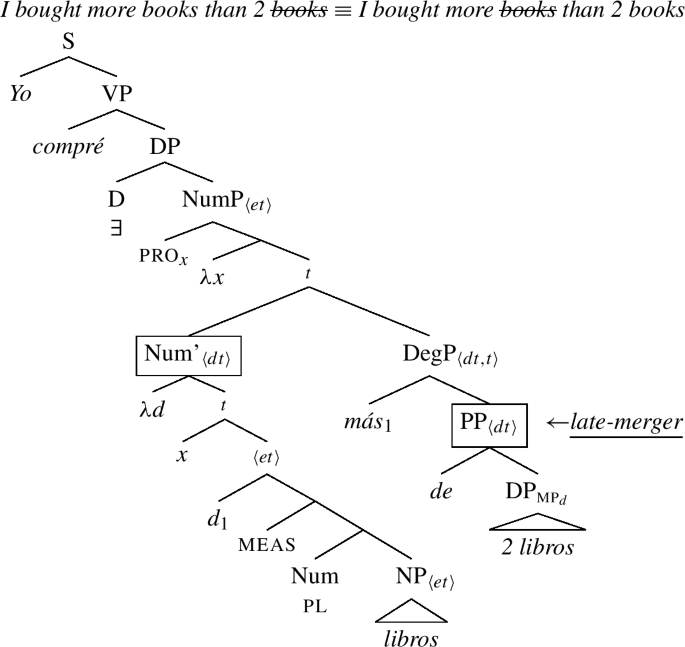
-
(63)

-
(64)
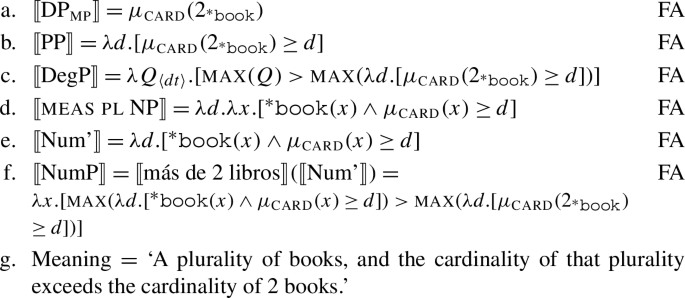
The derivation and computation of the meaning are consistent with the core of the proposal: más is a quantifier, de combines with a DPMP of type d, and there is no QR outside of the DP.
3.4 Free relatives and ACD
I have shown how giving de a semantic value unifies the analysis of más. In this Sect. 1 demonstrate that free relatives (both full and reduced) and resolution of ellipsis inside of them conform to the analysis that I am advocating for.
Following Donati (1997), I assume that free relatives involve movement of a wh-operator to the left periphery of CP and then a determiner merges with the CP relabelling the structure as a nominal. This operator movement can be overt as in (65a) or covert as in (65b).
-
(65)

We can assume that the syntactic structure of both (65a) and (65b) is identical with respect to the base position and landing site of the wh-operator: the operator moves to the left periphery of the clause, and binds a variable via lambda-abstraction at LF.Footnote 31 The structures differ regarding the realization of exponents at PF: if the operator is overt (e.g. cuanto ‘how much’) as in (65a), the complementizer is null and so is the determiner that relabels the structure; if the operator is null, the complementizer is spelled out as que and the determiner that embeds the CP is also spelled-out (e.g. lo ‘the.nt’), as in (65b). The determiner in charge of relabelling is also the one that does the maximalization regardless of whether it is overt or not.Footnote 32 The denotation for the maximalizing determiner is provided in (66):
-
(66)

The same is true of reduced free relatives first shown in (15). The only difference is that the operator in charge of the abstraction is null and so is the complementizer. But the D in charge of the maximalization is overt. In fact, it is possible to have an overt gradable predicate inside them which provides evidence for a larger structure and operator movement, as in degree questions. This behavior parallels free relatives as shown in (67) (see also Fábregas 2020: pp. 81–82):
-
(67)

Pied-piping of the adjective is optional, as independently attested in degree questions in Spanish (Gergel 2009, 2010; Eguren 2020). Thus, given the structural parallelism between the two constructions, we should analyze these reduced free relatives on a par with full free relatives in terms of degree abstraction: a degree operator moves to the left periphery and it creates a λ-abstractor that binds the degree variable left after operator movement. This is shown in (68):
-
(68)

That said, the free relative in (69a) has the LF in (69b), and its corresponding semantic derivation is in (70).Footnote 33
-
(69)

-
(70)

DP2 in (70a) denotes a degree. But this cannot combine with our degree quantifier más because the latter requires a set of degrees 〈dt〉. Thus, the preposition de lifts the type of its complement: a function from degrees to sets of degrees. Más can then compose with (70b) via Function Application.
With this in mind, we can now revisit the cases of ACD within free relatives. A particularly relevant example was (26) repeated below as (71).
-
(71)
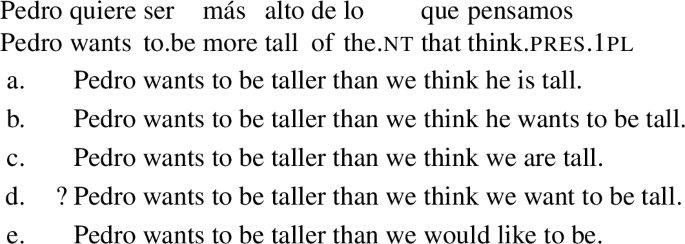
When this example was first discussed, I noted that the verb pensar was lexically ambiguous between ‘to think’ and ‘plan to/want to become’ which led to different selectional restrictions on the clause it embeds: the former requires a finite CP, while the latter requires a non-finite clause. Both types of pensar, however, enable an ACD site inside the standard. One way to resolve ACD is via QR (May 1985; Fox 2002; Bhatt and Pancheva 2004; Hackl et al. 2012). The analysis of más as a generalized quantifier over degrees allows us to adopt this solution. QR needs to target a node that is high enough to remove the ellipsis site from the c-command domain of the antecedent.
The example in (71) is 5-way ambiguous, with interpretations (71a)-(71d) being resolved by a finite clause complement, and the one in (71e) being resolved by a non-finite complement. These can be obtained by making QR available to different positions in the structure. Let’s focus on the four finite ACD sites first with pensar meaning ‘to think.’ The LFs for each interpretation are given in the bracket diagrams in (72):
-
(72)
Finite clause ACD site resolution of (71)

For (72a) and (72c), QR must take place to the edge of the embedded clause. The ACD site is resolved by copying the embedded TP. The verb pensar ‘to think’ in the standard requires that its TP complement be finite. This entails that a null pronoun must be the subject of the copied clause. There are two potential sources for pro resoltuion: Pedro or the 1pl pronoun we. Binding of pro by Pedro results in the LF in (72a), whereas binding by we results in (72c).
Contrary to this short QR, long QR of the DegP to the edge of the matrix clause renders different results. The antecedent of the ellipsis is now the whole clause: (72b) and (72d). Therefore, the ACD site includes the matrix verb want and the subject, given the finiteness requirement imposed by pensar on its complement. Again, the different interpretations arise due to a difference in binding options: if pro is bound by Pedro, so will be pro inside the ellipsis site giving rise to (72b); if pro is bound by we instead, so will pro and the interpretation that we obtain is (72d).
The last possible interpretation that needs some discussion is (71e) with pensar meaning ‘plan to/want to become.’ When the verb pensar has this meaning, it is a control predicate and its complement must be non-finite: the subject of pensar must control the pro in the non-finite clause. For this reading to be available, the relevant LF has to be such that QR targets the edge of the embedded non-finite clause and the ACD is resolved with the non-finite CP. pro inside the standard is then controlled by we. The LF, illustrated in (73), is similar to the one in (72c) with the crucial difference of (non-)finiteness of pensar\(_{ \textit{plan-to}}\)’s complement.
-
(73)
Non-finite ACD site resolution of (71)
Pedrok wants [CP [more than wei think\(_{plan-to}\) proi to be tall] λd[prok to be d-tall]]
These data demonstrate that QR is a neccesary mechanism to recover the ellipsis site contained within the free relative. What is more, the Ellipsis-Scope Generalization in (12) is satisfied: the DegP must contain the antecedent of the ellipsis in its scope.
The same can be said about reduced free relatives, modulo the multiple ambiguity. It was shown in Sect. 2.2.4 that reduced relatives can also contain ACD sites, though the size of the ellipsis seemed to vary across speakers. The example used to illustrate ACD with reduced free relatives was (28) repeated as (74) for convenience:
-
(74)
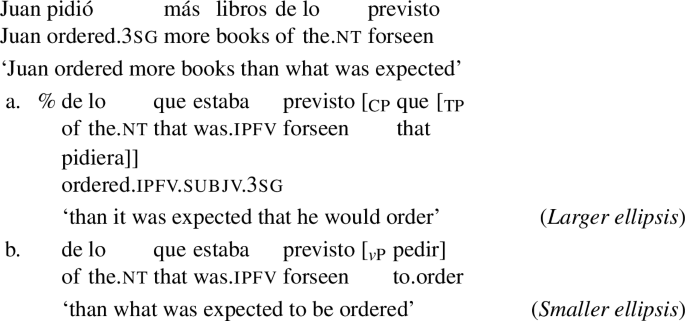
In fact, it was noted that the larger ellipsis site in (74a) correlates with the possibility of inverse scope, while there is no such correlation between the smaller one in (74b) and inverse scope. This is because the landing site and height for QR are different for the two ACD options. In order to resolve the larger ellipsis site, QR must target the TP above the external argument. On the contrary, the smaller site is obtained via QR to the edge of the vP, which has been argued independently to be a scope position (Fox 1999; Legate 2003; Cecchetto 2004). The lower copy of the verb inside vP is uninflected, and so will the vP contained in the ellipsis site. The different structural options for (74) are provided in (75):
-
(75)
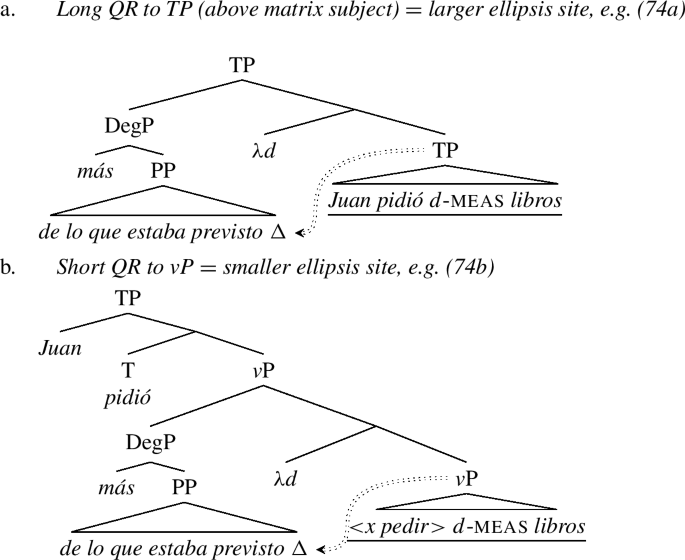
Given these structures in (75), the question is why inverse scope over a modal is only possible in (75a) but not (75b). The answer is that modal operators are merged into the structure higher than vP, but arguably lower than tense (Iatridou and Zeijlstra 2013). For cases like (75b), this entails that even if we reconstruct the modal to its base position (above vP), the degree quantifier will still be in the modal’s c-command domain. Thus, if these speakers do not allow the ACD site to be larger than vP, it makes sense that they do not accept inverse scope either. On the contrary, inverse scope is possible in (75a) because the DegP undergoes QR higher than T, which is the modal’s final landing site, assuming all verbs in Spanish raise to T.Footnote 34
3.5 Taking stock
I have shown how the proposal that más is a generalized quantifier over degrees can handle both clausal and phrasal-MP comparatives. The proposal has contributed to a deeper understanding of the syntax of comparative numerals, which plays a significant role in the analysis of de-comparatives. In particular, I have provided substantial evidence for a particular syntax of comparative numerals which establishes a parallelism with the syntax of numeral differential comparatives. The proposed structure has shed light on the kinds of arguments that de must take in the syntax and the semantics: de always selects a full MP and never a bare numeral or a pronominal. In fact, either of these options are found on the surface due to NP ellipsis.Footnote 35
Regarding phrasal MP comparatives more generally, I have demonstrated that, by providing a uniform syntax for más and a semantic meaning for de, the uniform analysis makes the right predictions with respect to extraposition, scope and ACD resolution. The proposal enables QR of más to a node of type t regardless of whether this node is DP/AP internal or higher up in the clause (e.g. vP, TP). Though it has been hinted that the reason for each target of QR has to be motivated—for example by the need to resolve a type mismatch or to resolve ACD—the next section is devoted to address these issues and discusses the locality of QR.
4 The locality and height of QR
In Sect. 2.2.2 I formulated a generalization that focused on the relation between clausal extraposition and phrasal comparatives. The generalization, stated in (17), is repeated in (76) for convenience:
-
(76)
The de-Extraposition Generalization (DEG)
de-standards containing a numerically modified NP or a pro-form cannot appear extraposed at the clausal level.
This generalization was complemented by the generalization on Table 1, which has been updated as Table 2. According to Table 2, there can be different diagnostics to probe the locality of QR.
Más is a quantifier and it will have to QR to avoid a type mismatch at the base position. In addition, QR enables a particular kind of ellipsis, and since the size of ellipsis corresponds to the height of QR—an independent generalization due to Sag (1976) and Williams (1974, 1977)—the small ellipsis size in NPs needs just a short QR. Thus, since numeral or pronominal standards only show instances of the latter, the degree quantifier must QR to the closest node where it can satisfy that property and resolve the type mismatch: the NP domain. As a result, the standard cannot surface to the right of the clause; it must remain DP-internal. On the contrary, since resolving ACD and obtaining inverse scope involve longer movements, to nodes at the clausal level, surface extraposition of the standard into the clause is guaranteed.
In other words, the conditions that determine the length of QR depend on the diagnostics that we are using to test for it. For example, QR is typically regarded as a clause-bounded operation but under certain circumstances, such as the need to resolve ACD, a quantificational element can QR outside of the containing clause (Kennedy 1997a; Wilder 1997; von Fintel and Iatridou 2003; Cecchetto 2004). In fact, as argued by Cecchetto (2004), there are three main motivations for QR: to resolve a type mismatch, to get inverse scope or to avoid the problem of infinite regress in ACD configurations. These are the operations described in Table 2. I adopt a version of Scope Economy (Fox 1999, 2000, 2002; Cecchetto 2004) such that every step of successive cyclic QR must be independently motivated by at least one of the operations mentioned.Footnote 36
If we take a de-standard with a numerically modified NP, the degree operator must QR (i) to resolve a type mismatch and (ii) for the ellipsis site to be resolved appropriately under identity. The degree operator could in principle raise to a DP-internal node (May 1985; Heim and Kratzer 1998; Hackl 2000; Matushansky 2002) or to the vP edge (Legate 2003). However, the longer movement is not motivated since the only ellipsis to be resolved is that of the NP. Thus, QR beyond the DP is ruled out by Scope Economy.
The situation is identical in the case of degree-denoting pronouns, e.g. de esod, considering that pronouns are definite determiners whose complement has undergone ellipsis (Postal 1966; Elbourne 2001, 2005). A Vocabulary Insertion rule (Halle and Marantz 1993) is responsible for spelling out D as eso at PF.
The situation is different with free relatives. I have provided evidence that the need to resolve ACD triggers long QR. In fact, examples like (71) were ambiguous depending on the landing site of QR: embedded or matrix clause.Footnote 37 Long QR of this type predicts that interaction with intensional predicates should in fact be possible. This prediction was also borne out as illustrated in Sect. 2.2.3. Unlike for numeral and pronominal standards, where there was no motivation to abandon the more local position, QR is motivated to obtain inverse scope, and thus allowed by Scope Economy.
The same holds for reduced free relatives, though more inter-speaker variation should be factored in. We also found cases in which the size of the ACD site could vary: vP or TP. Regardless of the size of the ellipsis, both options in (74) support the hypothesis that the degree quantifier must QR at least as high as the vP. For some speakers, QR to the highest TP node is also available as indicated with (74a), where the external argument Juan is reconstructed inside the ellipsis site.
Regarding scope with respect to intensional predicates, only those speakers who accept larger ellipsis sites are able to find sentences like (22) and (23) felicitous with the inverse scope. As mentioned at the end of Sect. 3.4, this is expected if modal operators are (reconstructed) higher than vP, but lower than T (Iatridou and Zeijlstra 2013). As a result, if the speaker’s grammar does not find a motivation to posit QR higher than vP, neither inverse scope nor large ACD will be allowed. This is also borne out (see fn. 14).
In conclusion, I have made use of a version of Scope Economy, based on Fox’s (1999, 2000, 2002) and Cecchetto’s (2004), such that every step of successive cyclic QR must be independently motivated by at least one of these operations: type mismatch resolution, NP ellipsis, inverse scope and ACD resolution. I have then argued why QR, when de takes MPs including numerically modified NPs and degree-denoting pronouns, must always be extremely local: the type mismatch and the NP ellipsis are resolved by positing a DP/aP internal scope position. Since the ellipsis site can be resolved locally, QR to a structurally higher position is ruled out by Scope Economy. Thus, the lack of scope interactions with modals and the lack of clausal extraposition follow. With respect to free relatives, long QR is allowed by Scope Economy due to two major reasons (each of them independent from the other): the possibility to resolve ACD and inverse scope.
5 Comparing the current uniform analysis with Mendia’s (2020)
I have advocated for a uniform analysis of comparatives, according to which más is a generalized quantifier with the same syntax and semantics across the board. Any observed differences between comparative constructions stem from the syntax and semantics of the standards of comparison. We can refer to this as the Single “más” Hypothesis. The hypothesis is also grounded on a robust cross-linguistic observation: there is no language that we know of that uses different comparative morphemes, e.g. compr1 and compr2, to make a distinction between phrasal and clausal comparatives; the morpho-syntactic—and semantic–distinction is always found on the standard (Pancheva 2006; Bale 2008; Bhatt and Takahashi 2011; Bobaljik 2012: a.o.).
This is not the only possible account. In fact, an alternative has been developed by Mendia (2020) who proposes that the source of the distinct properties is not the standard but the comparative morpheme: más is ambiguous between máscls (i.e. clausal más) and másphr (i.e. phrasal más). We can refer to this as the Two “más” Hypothesis. In this section, I will briefly summarize Mendia’s main proposal and motivations and then I will discuss some potential challenges that it faces compared to the Single “más” Hypothesis.
5.1 Mendia’s (2020) clausal más
Mendia adopts Bresnan’s (1973) “classical analysis” for máscls, represented in (29): máscls and the que-standard form a DegP constituent at base-structure which occupies a specifier position of the phrase it modifies. Semantically, Mendia follows Heim (2001) and analyzes máscls as a generalized quantifier of type 〈〈dt〉,〈dt,t〉〉: máscls composes with the que-standard and then the whole DegP undergoes QR to a higher node. Mendia motivates this analysis for máscls based on clausal extraposition of que-standards and the availability of inverse scope with modal operators.
This is largely identical to the analysis that I have proposed. The only difference is that I am assuming Bhatt and Pancheva’s (2004) version of the classical analysis, according to which the standard is late-merged after QR of más. As a quantifier, -er/más is non-conservative (Keenan and Stavi 1986; Bhatt and Pancheva 2004), and traces/copies are interpreted as variables bound by λ-abstracting nodes (Heim and Kratzer 1998; Fox 2001, 2002). When the interpretation of traces/copies is combined with the non-conservative semantics of -er/más, early merger of the standard of comparison and the interpretation of its copy after QR leads to a contradiction—the standard is interpreted twice (i) as the restrictor of -er/más, and (ii) inside the second argument of -er/más. Late-merger of the standard avoids the contradiction: after QR of -er/más, all that is left to deal with is the lower copy of the quantifier.Footnote 38 Mendia (2020) does not make the late-merger assumption and thus the analysis faces the non-conservativity problem.
5.2 Mendia’s (2020) phrasal más
When discussing de-comparatives, Mendia (2020) assumes a different syntactic structure: másphr and the de-standard are never in a head-complement relationship. Instead, the complement of másphr is the gradable predicate. This syntactic geometry follows the “direct analysis” of comparatives (Abney 1987; Larson 1988; Corver 1990, 1997; Kennedy 1997b, 1999; a.o.). In the case of adjectival comparatives, másphr and the adjective are heads in the same extended projection; the standard is a right-adjoined adjunct. The same is true of nominal comparatives: másphr is a head in the Noun’s extended projection (Mendia 2020: p. 613, ex. 81). The relevant structures are in (77).
-
(77)
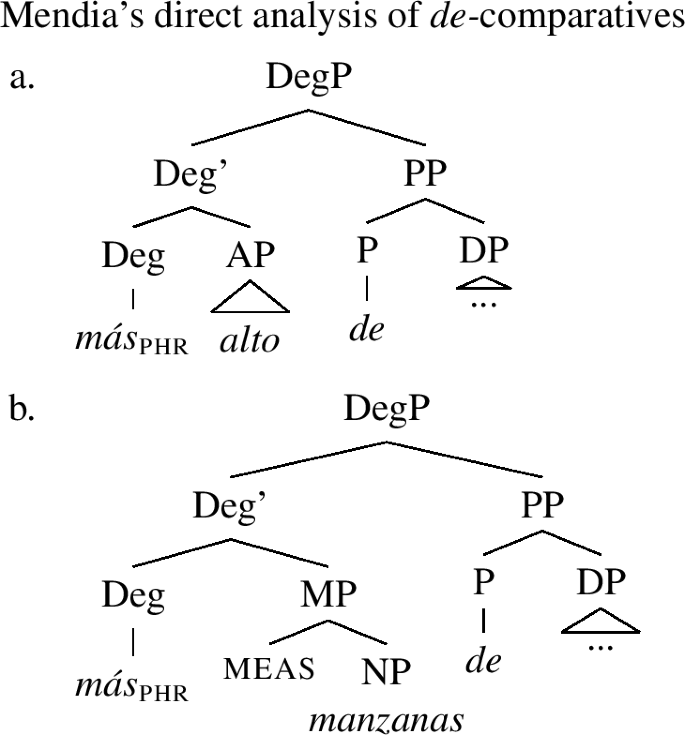
Semantically, másphr is not a quantifier but a three place predicate: it takes a gradable predicate, the de-standard of type d, and an individual. In this case más does not QR, and is interpreted in its base position (Kennedy 1997b, 1999). The denotation for másphr is in (78).
-
(78)

Mendia (2020) argues for the entry in (78) based on the following two observations: de-standards can never appear extraposed into the clause and másphr does not take inverse scope over modals.
As is, however, there are a series of challenges that Mendia’s analysis of de-comparatives faces. I comment on these below.
Challenge i: Extraposition, inverse scope and ACD.
As I have shown in Sects. 2.2.2 and 2.2.3, and summarized in Table 2, the observations which Mendia’s conclusions are based on are not entirely accurate. While de-standards hosting numerically modified NPs and degree-denoting pronouns cannot appear extraposed into the clause, de-standards introducing free relatives may, though. Furthermore, when the standard is able to appear extraposed higher than vP, inverse scope interpretations are grammatical. To this, we need to add the Ellipsis-Scope Generalization and the ACD facts discussed in Sect. 2.2.4. All in all, the direct analysis misses important generalizations concerned with the distribution of de-comparatives. All these facts, however, can be straightforwardly derived if más is a quantifier as I have shown.
One might wonder, as one reviewer does, whether these facts, and in particular extraposition, can be explained by alluding to Heavy NP Shift: numerically modified NPs and degree-denoting eso are “lighter” than free relatives. If this were the case, the difficulty of extraposition for de-comparatives would be determined by a more general ban on smaller constituents: “heavier” PPs (e.g. de+free relatives) are easier to extrapose than “light” ones (e.g. de+numeral/eso).Footnote 39
While I agree with the reviewer that extraposition of “heavier” constituents is easier and has been observed in the literature (Ross 1967; Baltin 1978, 1987), there are empirical arguments indicating that extraposition of de-standards is not driven by heaviness. First of all, heaviness only affects DP-extraposition. Other constituents such as PPs and CPs are exempt from the heaviness requirement—a fact also observed by Drummond (2009) for English. Consider the examples in (79):
-
(79)
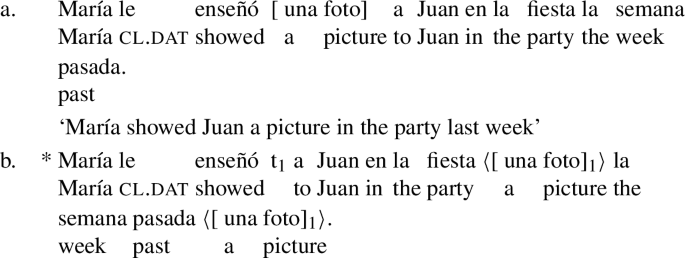
In (79a), the direct object una foto ‘a picture’ is light and occupies its unmarked position—i.e. higher than the indirect object (Demonte 1987, 1995; Cuervo 2003). When it moves to the right past the adjuncts as in (79b), ungrammaticality obtains. These data in (79) contrast with the extraposition of a light PP, shown in (80) and (81):
-
(80)
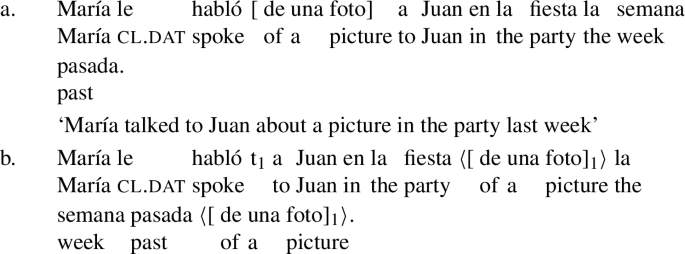
-
(81)
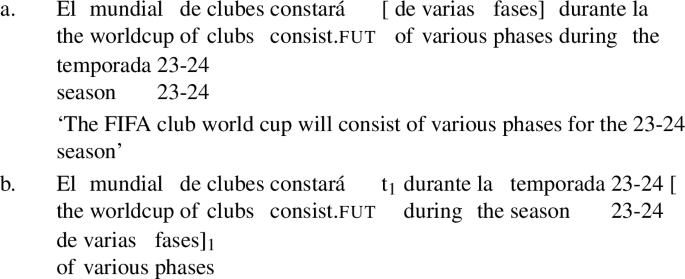
The PP de una foto ‘of a picture,’ which is a required complement of the verb hablar ‘to speak (about),’ is also light: in addition to the preposition, it only contains a two-word DP. Despite its lightness, the PP can undergo extraposition past the adjuncts as in (80b). Likewise, the PP-complement of constar ‘consist (of)’ in (81), which is obligatory and cannot be dropped, is also light and can appear extraposed as in (81b).Footnote 40
Numerically modified phrases like 100 dólares ‘100 dollars’ can also extrapose in non-comparative contexts despite the fact that they are not very heavy: compare (82) below with (14).
-
(82)

In addition to this, evidence that such PP-extraposition, including phrasal standards, is not affected by heaviness is supported by subextraction from subjects. Subjects are typically islands for extraction (Wexler and Culicover 1980), but their islandhood is voided in the passive (for Spanish, see Torrego 1984; Gallego 2010; Toquero-Pérez 2021). Extraposition of a DP-internal de-PP can occur from the subject position in Spec,vP as in (83):
-
(83)
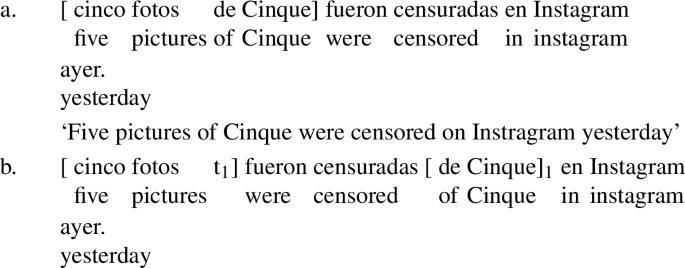
Nevertheless, if an equally heavy de-PP standard is attempted to be extraposed from the same passive subject, the sentence is ungrammatical. This is illustrated in (84):
-
(84)
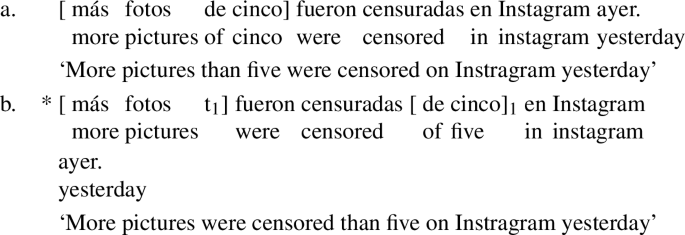
The data in (84) reinforce the observation that PPs can easily extrapose into the clause regardless of heaviness (Drummond 2009) or whether they are optional or obligatory. Thus, de-standards, which are also PPs, are not expected to be subject to this requirement. In fact, reduced free relatives are also light, i.e. they are two-word DPs, and can surface extraposed into the clause. The surface order restrictions that certain de-standards are sensitive to must be determined by a different requirement.Footnote 41
Challenge ii: Constituency, selection and the syntax of comparative numerals.
Mendia’s (2020) proposal does not only entail a semantic ambiguity of más; assigning two meanings for más also has the consequence of attributing a distinct, i.e. ambiguous, underlying syntax for the comparative morpheme. Under the direct analysis for de-comparatives, the de-standard is not the syntactic complement of másphr, but it is adjoined to the projection that dominates más and its complement, e.g. (77). This syntactic structure fails to capture the c-selectional restrictions that exist between the comparative head and the standard of comparison (Bresnan 1973; Carlson 1977; Bhatt and Pancheva 2004; Bhatt and Takahashi 2011). This is specially problematic if we take c-selection as strong evidence for head-complement relations (Chomsky 1957, et seq.).Footnote 42
This issue about the constituency of más and the standard is related to the the syntax of comparative numerals. As I have argued building on Arregi (2013), the comparative morpheme and the standard must form a constituent. This goes against the geometry in (77b). What is more, if such a syntactic analysis is on the right track, there are important consequences for the semantic composition proposed by Mendia (2020) in (78): másphr requires its first argument to be saturated by the gradable predicate of type 〈d,〈et〉〉, but given the alternative motivated constituency it must be saturated by the standard of type d or 〈dt〉. Thus, the derivation should crash.
Under the uniform analysis of comparatives, none of these present an issue: (i) más and the standard are always in a head-complement relation at some point in the derivation, and (ii) the standard of comparison always saturates más’ first argument.
5.3 Distinguishing between the two analyses: Suppletion and synthetic comparatives
In addition to the different predictions that the two analyses make with respect to the syntax and semantics of comparative constructions, there are also distinct morphological predictions that are worth discussing. These are concerned with the formation of suppletive comparative formation on adjectives.
Suppletive vocabulary items are subject to stringent locality conditions: the trigger and the target of suppletion are required to be structurally adjacent post-syntactically (i.e. after spell-out) (Bobaljik 1995b, 2012; Embick and Noyer 2001; Embick 2007, 2010; Dunbar and Wellwood 2016; Bobaljik and Harley 2017). There are two potential ways that fall under the label structural adjacency: the two heads are part of the same extended projection in (85) or they belong to different extended projections in (86). The double arrows indicate that the two elements are structurally adjacent.
-
(85)
X and Z are both heads in the same extended projection
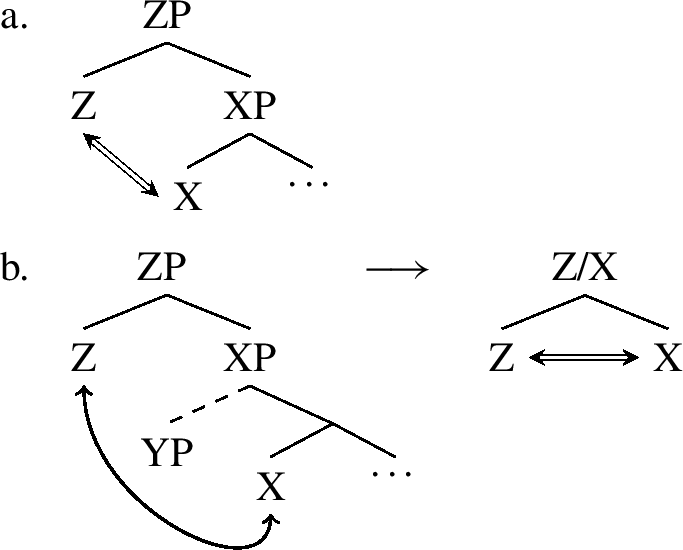
-
(86)
Z heads ZP which is a specifier of X

X and Z are part of the same extended projection and Z immediately c-commands X in (85a). Their structural adjacency can be preserved even if there is a phrasal intervener YP between Z and X via incorporation as depicted in (85b) (Emonds 1976; Travis 1984; Baker 1988; Noyer 1992; a.o.). The adjacency is only blocked if there is an additional head Y located between X and Z. On the contrary, Z and X in (86a) are not part of the same extended projection: Z is a head of ZP located in the specifier of X. They are (“linearly”) adjacent because there is nothing that intervenes between them. In case of an intervener, e.g. YP, adjacency is blocked as in (86b) (Marantz 1988; Embick and Noyer 2001).
The different syntactic structures and scenarios described have implications for suppletion. In (85), a head Z can trigger suppletion of X unless there is a head Y that intervenes between them. On the contrary, in (86) Z in ZP can trigger suppletion of X if and only if there is no intervener there is a YP that is closer to X than ZP.
Implications and predictions for analyses of Spanish comparative constructions.
The two schematic structures in (85) and (86) remind us of the different syntactic geometries for que and de-comparatives: (30a) = (86a) and (77) = (85a), respectively. Given that the two structures make different predictions with respect to suppletion patterns, we can test them to distinguish between the two competing analyses. The relevant patterns involve suppletion of the adjective triggered by the comparative.
The Two “más” Hypothesis predicts an asymmetry between que and de-comparatives with respect to the suppletion and synthetic comparative formation patterns, given the two distinct structures it rests upon. The predictions are outlined in (87):
-
(87)

(87a) predicts that the comparative will not trigger suppletion on the adjective if más heading the DegP is in a specifier position, e.g. (86b). The comparative is expected to be analytic, rather than synthetic. (87b) predicts that the comparative will trigger suppletion of the adjective if más is a head in the extended projection of the adjective, e.g. (85b). The comparative will be synthetic.
On the contrary, the Single “más” Hypothesis that I proposed in this paper is grounded on a single syntactic structure: the Deg(P) is a specifier of the element it modifies, including adjectives. Thus, we expect no asymmetry in suppletion or synthetic comparative formation. In fact, the prediction given in (88), is the same as the one made by the Two “más” Hypothesis for que-comparatives.
-
(88)

Let’s start with the observation that Spanish has very few synthetic comparative adjectives, and the few available are also suppletive. An example is given in (89).
-
(89)

As observed by Embick (2007) and Dunbar and Wellwood (2016), some adverbials like increíblemente ‘incredibly’ are ambiguous between two possible interpretations when modifying an adjective in predicative position. One interpretation is “evaluative” and the other describes the manner (or degree) in which the subject of the predication instantiates the property denoted by the adjective. An example with the positive form of the adjective bueno ‘good’ is given in (90), with the corresponding paraphrases.
-
(90)

The interpretive ambiguity has been argued by these authors to be the result of a structural ambiguity. The “evaluative” reading is obtained when the adverbial is structurally higher than the position corresponding to the “manner” interpretation (Cinque 1999, 2010; Scott 2002; a.o.): Adveval > ⋯ > A vs. Advmanner > A. This order is independently motivated based on word order patterns with degree modifiers like muy ‘very.’ When muy precedes the adverbial and the adjective, only the manner interpretation is grammatical; but, when the adverbial precedes muy and the adjective, only the evaluative one is possible. The contrast is shown in (91).Footnote 43
-
(91)

The data in (91) are crucial because they show that Deg(P)s are structurally higher than the AdvP conveying a manner reading: Adveval > Deg > Advmanner > A.Footnote 44
Thus, the question is whether an adverbial like increíblemente with a manner interpretation blocks the suppletion of the adjective triggered by the comparative morpheme, resulting instead in the analytic form of the comparative. If it does so only with que but not de-comparatives, we will have found support for Mendia’s (2020) Two “más” Hypothesis. However, if the suppletive form is always blocked upon the presence of the adverbial, we will have found support for the Single “más” Hypothesis. These predictions are summarized in Table 3.
Testing the predictions i: Que-comparatives.
The relevant data for que-comparatives are shown in (92). (92a) is the baseline illustrating that suppletion/synthetic comparative formation are possible.
-
(92)
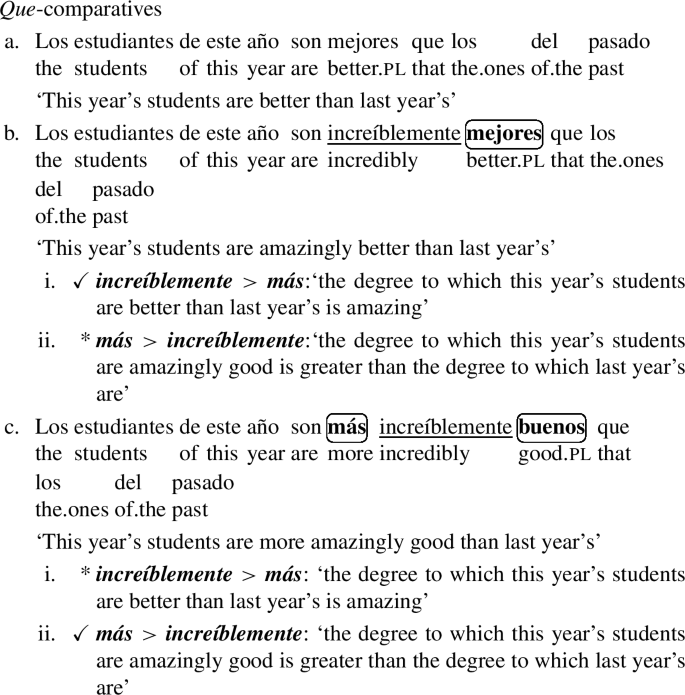
In (92b), the adverbial increíblemente precedes the suppletive comparative adjective. However, what is crucial is that the sentence is only grammatical with the evaluative interpretation where the AdvP is higher than Deg(P) and A; and it is ungrammatical with the manner interpretation. For the manner interpretation to be obtained, the analytic comparative and non-suppletive form of the adjective must be used. That is the case in (92c).
What we can conclude from this is that both hypotheses make the correct predictions with respect to que-comparatives: an intervening AdvP blocks suppletion on the adjective resulting in an analytic comparative form. Thus, we can conclude that the comparative morpheme and the adjective are part of separate extended projections and the structure must be as in (86a).
Testing the predictions ii: De-comparatives.
We have established the baseline with que-comparatives settling on the schematic syntax in (86a). The critical case, where the two hypotheses differ, is de-comparatives. The relevant paradigm is in (93), where once again (93a) is the baseline. The choice of a free relative inside the standard is to make the sentence more natural. Nothing crucial hinges on this decision:
-
(93)
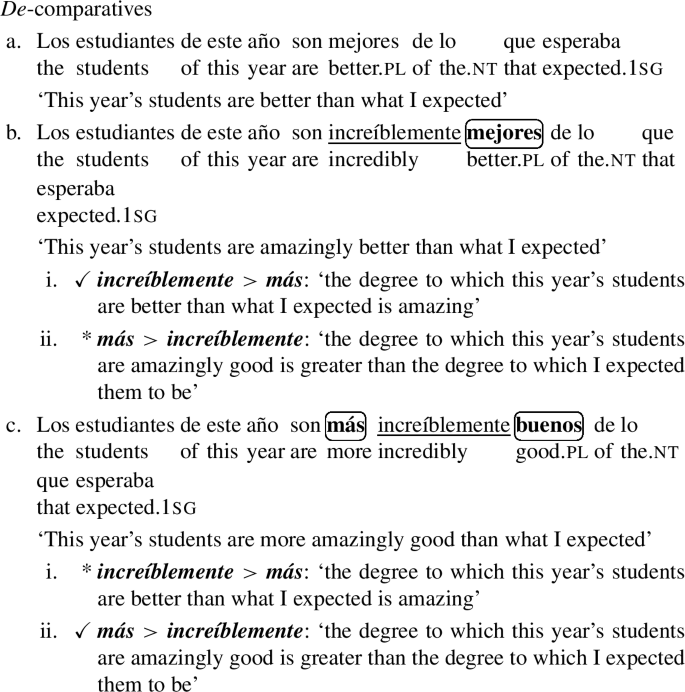
The patterns in (93) with de-comparatives are no different from the ones in (92) with que-comparatives. While it is possible that the adverb precedes a synthetic and suppletive comparative adjective in (93b), the interpretation is an evaluative one. This does not match the intervention condition that we are probing since the evaluative AdvP is higher than the degree constituent. On the contrary, when the AdvP gives rise to a manner interpretation in (93c), suppletion on the adjective is therefore blocked and the comparative is analytic. We conclude then that the manner AdvP must be sandwiched between the comparative morpheme and the positive form of the adjective.Footnote 45
This structural blocking effect is predicted by the Single “más” Hypothesis because the syntactic structure is the same across the board, regardless of whether the standard is introduced by de or que. However, the blocking effect is not expected by the Two “más” Hypothesis: Deg and A are both heads in the same extended projection and their structural adjacency cannot disrupted by a phrasal intervener. In other words, the comparative form of the adjective is predicted to be suppletive.
All in all, we can take these facts as strong evidence against the Two “más” Hypothesis. The data in both (92) and (93) support a uniform syntactic structure for comparatives: the comparative morpheme must head a DegP in a specifier position of the extended projection of the category that it modifies (Bresnan 1973; Heim 2001; Bhatt and Pancheva 2004; Embick 2007; Dunbar and Wellwood 2016).
6 Spanish and the broader cross-linguistic picture
I have argued in this paper that Spanish has two types of comparatives: a clausal comparative and a nominal MP comparative. These MP standards, though introduced by the preposition de, are not derived from a reduced clausal analysis. Even though this is a particular fact of the grammar of Spanish, it is not uncommon to find languages that make a clausal-phrasal distinction but use the phrasal morpho-syntactic standard to introduce MP comparatives. For example, this is the pattern found in Serbo-Croatian, Russian and Greek.Footnote 46 I call these phrasal purely descriptively, but the constructions in these languages have received a reduced clausal (or a small clause) analysis.
Pancheva (2006) notes these languages have a clausal-phrasal distinction. In Russian clausal comparatives, the degree operator is overt and the standard marker is null. The XP inside the standard shows case connectivity with the comparee in the matrix (94a). Phrasal comparatives have no overt standard morpheme either; the XP inside the standard bears genitive case (94b).
-
(94)

Crucially, when the standard is an MP, Russian requires the MP to be genitive marked. In fact, the degree operator is not acceptable in MP comparatives (95).Footnote 47 All this is evidence for the fact that MP comparatives in Russian are phrasal
-
(95)

Similarly, Serbo-Croatian uses a clausal standard morpheme nego- ‘than’ and a phrasal one od ‘from.’ Once again, in clausal comparatives, there is case connectivity (96a)—Tanja bears nominative case—while in phrasal comparatives od imposes genitive case on its complement (96b):
-
(96)

MP comparatives require the standard morpheme od and genitive case, as in Russian. This is illustrated in (97):
-
(97)

Pancheva (2006) proposes that in these languages, the comparative morpheme is a generalized quantifier over degrees, and that the standard marker has a different semantics depending on whether it introduces a full clause of type 〈dt〉, or a small clause or MP of type d in the case of phrasal comparatives.
The proposal I have put forth here owes a great deal to the insight of Pancheva’s (2006) analysis. In fact, I have shown how an analysis along the same lines enables us to capture overlooked generalizations in Spanish, but also to establish generalizations about the grammar of comparative constructions more generally.
These data, though based on a small sample of languages (Spanish, Russian, Serbo-Croatian, Greek), seem to point to a correlation or a tendency between phrasal and MP comparatives. However, that is not entirely right since there are languages that morpho-syntactically distinguish clausal and phrasal comparatives, but express MPs clausally. Two languages that I am aware of are Polish (Pancheva 2006) and Lithuanian (Vaikšnoraitė 2021).
In Polish, the standard morpheme niż ‘than’ introduces clausal complements, whereas the morpheme od (as in Serbo-Croatian) introduces a nominal complement which is genitive marked. Interestingly, as opposed to Russian or Serbo-Croatian, MP comparatives are introduced with niż instead of od. The Polish paradigm is given in (98):
-
(98)
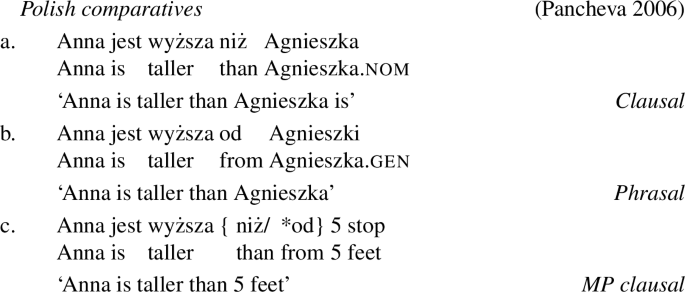
Likewise, it has been argued that in Lithuanian, another language which makes a clausal vs. phrasal distinction, MP comparatives are only compatible with the clausal standard. The clausal standard is negu and the comparee must be the subject (99); the phrasal standard is už, which case marks its complement as accusative. MP comparatives must be introduced with negu. The Lithuanian paradigm is given in (99):
-
(99)
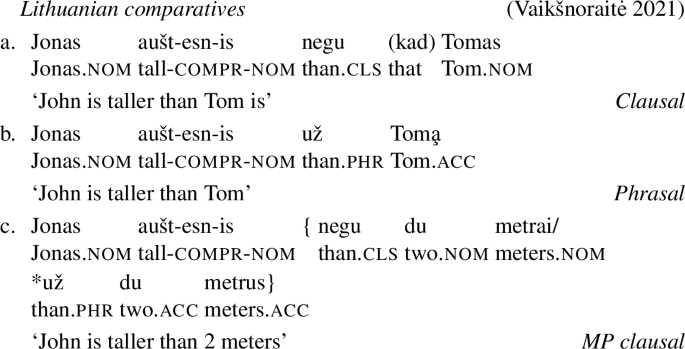
In short, the data contribute to the great cross-linguistic variation in the expression of comparison, and more particularly in the grammar of measure phrases. The cross-linguistic picture that emerges from this is summarized in Table 4.
We can classify these languages into 3 groups depending on the type of syntactic constituent allowed inside the standard: Type 1, Type 2 and Type 3 languages. The category “other” stands for any non-nominal constituents such as PPs, APs etc. Although in the case of the clausal comparatives, the complement of the standard is always going to be a TP—the standard morpheme is generally a complementizer—we are interested in the types of remnants that are allowed.
In Type 1 languages (e.g. Spanish), the phrasal standard marker can only select for a (degree-denoting) MP, whereas the clausal standard, which always introduces a clause, can have different types of remnant consitutents as long as they are not (degree-denoting) MPs. Type 2 languages (e.g. SC) differ from Type 1 in that they also allow (case-marked) DPs to be the complement of the prepositional marker: the case on the DP or the measure phrase is licensed by the preposition. Type 3 languages differ from the previous two with respect to the fact that MPs are only possible when the standard is clausal. In none of these languages, the clausal marker itself licenses case on the remnants.
An immediate question that is raised by the data on Table 4 is why MPs in some languages combine with a phrasal or a clausal standard morpheme. One potential answer is that there is a semantic restriction, i.e. s-selection. MPs are ambiguous between a degree interpretation d or a predicate of degrees 〈dt〉 (Schwarzschild 2002; Schwarzschild and Wilkinson 2002; Rett 2014). Likewise, as I have shown following previous literature (Pancheva 2006; Bale 2008; Alrenga et al. 2012), standard morphemes can select for a semantic argument that is either a degree or a set of degrees. Thus, the well-formedness of MP comparatives is determined by the matching semantic requirements of the standard morpheme and MP complement: if the standard marker is of type 〈〈dt〉,〈dt〉〉 but the MP is of type d, the derivation crashes. That is the case of Spanish que-comparatives.
In Slavic and Baltic languages, phrasal standard markers are of type 〈〈dt〉,〈dt〉〉 according to Pancheva (2006): in Russian and Serbo-Croatian, MPs must be then predicates of degrees allowing the semantic composition, whereas in Polish and Lithuanian they must be definite degrees making the derivation crash. On the contrary, clausal markers in these languages are of type 〈d,〈dt〉〉 which make Polish and Lithuanian MPs a suitable argument for them.
The purpose of this section has been to compare Spanish comparative constructions with those of other languages. I have shown that, though there are similarities between Spanish and other languages that make a clausal vs. phrasal distinction in the morpheme introducing the standard, there are also important differences. For example, Spanish is the only language that does not allow any nominal complement inside the phrasal standard: the complement must be an MP, which I have shown in the paper has to denote a degree. I have then argued that the distribution of MPs is related to the s-selectional requirements of the standard morpheme.
7 Conclusion
In this paper I have examined comparative constructions in Spanish which can be expressed by a phrasal (e.g. de+DP) or a clausal standard (e.g. que+CP). The comparative morpheme that establishes the ordering relation between degrees is the same one, though: más. While a uniform analysis of both types of comparatives constitutes a prima facie chaIlenge because of the variation across and within constructions, I have argued that it is possible.
The proposal that I advocated for, and which I have referred towards the end as the Single “más” Hypothesis, is based on a uniform syntax and semantics for the comparative morpheme and the DegP it projects. The source of the mentioned differences is the standard of comparison. Semantically, más is a generalized quantifier which always takes the late-merged standard as its restrictor argument. This analysis of comparatives enables capturing the full range of facts concerned with the surface position of the standard, inverse scope and ACD resolution. The claim that más is uniform follows from the fact that standard morphemes such as de must be meaningful (Pancheva 2006; Alrenga et al. 2012). Furthermore, the analysis receives support from the observation that differences between phrasal and clausal comparatives are always found in the standard, and never in the comparative morpheme (Pancheva 2006; Bhatt and Takahashi 2011; Bobaljik 2012; Wellwood 2015, 2019).
In addition, I have formulated a novel generalization regarding the extraposition of de-standards: numerically modified and pronominal NPs cannot extrapose into the clause, outside of DPs or APs. I argued that this is because QR of más higher than the most local node (inside the DP/AP) is not motivated and is thus ruled out by Scope Economy. This contrasts with free relatives whose higher landing site for QR is motivated by inverse scope or ACD resolution. One other advantage of the present proposal is the analysis of comparative numerals. Building on Arregi (2013), I have sketched an alternative that is still able to capture the original observations and extend them to Bulgarian. This syntax of comparative numerals has enabled us to derive pronominal standards from fully fleshed DPMP (i.e.the pronoun is the spelled-out exponent of D after its complement has undergone ellipsis at PF). What is important is that we need not assume or posit two different syntactic derivations for comparative numerals that are truth-conditionally equivalent. Not only has this analysis unified degree-denoting DPs inside standards but it has also established a parallelism with the MP differential arguments.
Mendia (2020) has proposed an alternative. I named it the Two “más” Hypothesis because it argues that any differences (between que and de-comparatives) stem from más being ambiguous: a generalized quantifier over degrees for clausal comparatives and a three-place predicate that is interpreted in its base generation position for phrasal ones. This hypothesis entails that the degree morphemes themselves are distinct and so are the syntactic structures they generate. While this hypothesis has provided a rich understanding of Spanish comparative constructions, I have demonstrated that an account based on semantic and syntactic ambiguity makes a series of undesirable empirical and conceptual predictions. On the empirical side, the proposal cannot account for the full range of extraposition, inverse scope and ACD facts; plus, it is incompatible with the syntax of comparative numerals. Moreover, given the syntax it assumes, it predicts an asymmetry in suppletion and synthetic comparative formation patterns which is not borne out. On the conceptual side, an analysis like Mendia’s (2020) and others before him, entails an ambiguity of sorts for more/más, itself unsupported in the morpho-syntactic evidence within Spanish and across languages.
All in all, a uniform analysis of comparative constructions is not only more parsimonious but also empirically superior.
Notes
Abbreviations: acc = accusative; cl = clitic; cls = clausal (marker); cm = class marker; compr = comparative; cond = conditional; ct = count form; dat = dative; f = feminine; fut = future; gen = genitive; ipfv = imperfective; m = masculine; nom = nominative; nt = neuter; perf = perfective; phr = phrasal (marker); pl = plural; pres = present; sg = singular; subjv = subjunctive.
In addition to this, the example in (2a) shows case connectivity: the DP él in the standard has nominative case and matches the nominative case of the comparee in the matrix clause (e.g. the DP ella ‘she’). Case connectivity is a strong argument to diagnose that the standard is underlyingly a clause (Lechner 2001; Pancheva 2006).
I will use the subscripts e and d to distinguish when eso is denoting an individual or a degree, respectively.
From now on, I will be glossing the definite determiner lo in free relatives as neuter (nt) to distinguish it from the masculine and feminine determiners el and la. This is a purely descriptive label. I am not committing to or endorsing the claim that lo has neuter gender. For more detailed discussion on this matter see Ojeda (1984), Toquero-Pérez (2022).
I will be using the term extraposition “largely pretheoretically, as a description of the cases where the degree clause appears discontinuous from the degree predicate, separated from it by sentential material such as adjuncts” (Bhatt and Pancheva 2004: 18). In the case of numerically modified NPs and degree-denoting pronouns, the de-standard is separated from más by DP/AP internal material.
A reviewer reports that extraposition of reduced free relatives as in (16b–16c) is degraded for them and some speakers that they consulted, especially if compared to the baseline without extraposition. Thus, the % mark. However, the reviewer acknowledges that extraposed reduced free relatives are less degraded than the ungrammatical counterparts in (14). Though the question about the variable acceptability of examples with extraposed reduced free relatives is an issue for further scrutiny, I provide some arguments in Sect. 3.4 that can explain this variation.
Whether this generalization applies to other languages that have phrasal comparatives or is particular to Spanish is unknown to me. I would like to leave this question for future research.
In Sect. 5.2 I argue that the extraposition facts cannot be explained by alluding to overt extrapostion, i.e. rightward movement, of the standard due to some independent property like heaviness.
I have consulted 10 native speakers of Peninsular Spanish from Valladolid (x3), Salamanca (x2), Asturias (x3) and Madrid (x2). Seven of them accepted both the inverse and surface scope readings with menos and exactly MP differentials. The other three did not accept the inverse scope with either de or que comparatives, and disliked inverse scope more generally with other quantifiers.
6/10 native speakers of Peninsular Spanish accept the inverse scope, whereas 4/10 do not. The same 6 speakers accept a larger ellipsis site, i.e. TP; the other 4 speakers only accept a lower ellipsis site, i.e. vP.
Sáez del Álamo (1987) considers examples like (24) with a modal such as deber ‘should’ or pensar ‘think’ to be cases of ACD, and provides the minimal pair in (ii):
-
(ii)

The contrast is explained based on the presence or absence of a quantifier. In (ii-a) the quantifier todos ‘all’ forces QR removing the ellipsis site from the c-command domain of its antecedent. However, when the DP containing the relative clause with the ellipsis site is headed by a demonstrative instead, the DP cannot abandon its base position. As a result, the only possible antecedent to resolve the ellipsis site will always contain it. If we look at the kind of comparatives in (24), we can apply the same logic: there is a modal or intensional element inside the free relative and a gap; and in order to avoid infinite regress inside the gap, the quantificational element has to move to a scope position where an appropriate antecedent will be plugged.
-
(ii)
The interpretation in (26d) is marked with ? because while it is logically possible to not be sure what height we want to be, it is not very sensible.
An example of pensar with the meaning of ‘to plan to’ is given in (iii):
-
(iii)

-
(iii)
See footnote 14.
I treat it as a degree modifier whereas for Mendia que is semantically vacuous. However, ultimately it is not a big difference.
I am assuming that in copular predicative constructions, the subject of the predication, i.e. Juan in (33), is generated in the specifier position of the AP along the lines of Manzini (1983), Koopman and Sportiche (1991). For syntactic reasons, namely case, the subject DP must move to Spec,TP. The copy left by the movement is interpreted as a variable of type e and saturates the adjective’s individual argument. Thus, the AP node is of type t: (iv). The e-type variable is then bound by the λ-abstractor in the DP’s landing site.
-
(iv)

Nothing crucial hinges upon this decision. Alternatively, one can adopt a small clause (cf. Stowell 1981) or PredP (cf. Bowers 1993, 2001) approach to predicative structures. In either case, the trace left by the moved DP will saturate the adjective’s individual argument.
-
(iv)
By “local relationship,” I am assuming “part of the same extended projection”; e.g the numeral is in a specifier introduced by a functional head in the N’s extended projection. cm-deletion cannot be subject to linear adjacency at PF. Otherwise, the presence of an adjective between the numeral uno and the NP should bleed the application of the deletion rule (Embick 2007 and references therein), giving rise to the ungrammatical string in (v):
-
(v)

-
(v)
For reasons that remain unclear, Arregi (2013) does not endorse the second NP2 in (37). However, Arregi does not consider the possibility of number mismatches like the ones in (40) and (39b). Arregi, in fact, claims that a structure like (37) “predicts that a language like Spanish is possible where the class marker on the numeral is deleted in simple numerals, but in which ellipsis of [the NP inside the standard] instead of [the standard external NP] results in no deletion of the class marker in comparative numerals” (Arregi 2013: 55). However, this is precisely the case of languages like Spanish: the class marker is deleted in simple numerals, e.g. (38a), and deletion of the NP inside the standard triggers no class marker deletion in the numeral, e.g. (39b). The prediction that Arregi claims not to hold is actually borne out.
An example of más modifying a singular count NP is in (vi).
-
(vi)

-
(vi)
Recently Pancheva (2021) has analyzed the “count” form as a portmanteaux morpheme encoding singular number and accusative case.
A reviewer asks what conditions force one of the NPs to be silent. It is unclear what the right answer is, specially because it is possible to find sentences in which the two NPs are deleted, e.g. (vii).
-
(vii)

I leave the answer to the question for future research, but note that optionality in NP-deletion is not uncommon cross-linguistically. For example, Ionin and Matushansky (2006, 2018) discuss complex cardinals and show that constructions like two hundred and twenty books are really two hundred
 and twenty books with NP-deletion in the first conjunct. However, in Biblical Welsh and Scottish Gaelic, NP deletion occurs in the second conjunct instead. In addition, in the two types of languages mentioned, both NPs can be deleted (e.g. two hundred
and twenty books with NP-deletion in the first conjunct. However, in Biblical Welsh and Scottish Gaelic, NP deletion occurs in the second conjunct instead. In addition, in the two types of languages mentioned, both NPs can be deleted (e.g. two hundred  and twenty
and twenty  ) but they cannot be both overt (e.g. * two hundred books and twenty books). Spanish comparative numerals are a mixture of the two types: either (or both) NP(s) can undergo deletion.
) but they cannot be both overt (e.g. * two hundred books and twenty books). Spanish comparative numerals are a mixture of the two types: either (or both) NP(s) can undergo deletion.-
(vii)
What is deleted must be larger than a bare NP. Unlike NP-deletion marked by a precise cardinal numeral or vague numeral, which allows number mismatches, when the demonstrative marks the ellipsis site, number mismatches are not allowed: the antecedent and elided constituents must be identical in number. This is illustrated in (viii). The constituent undergoing deletion must contain at least NumP.
-
(viii)

-
(viii)
One may still wonder whether by giving de a lexical entry to return a type 〈dt〉 argument we have pushed the ambiguity problem into a different domain. Although a parallelism following Pancheva (2006) has been established with partitive constructions, one could even abstract more and say the following: de is a polymorphic type-shifter of type 〈σ〈σt〉〉, where σ could be of any possible type (Charlow 2020). Thus, if σ is of type d, now we have 〈d〈dt〉〉. I thank Deniz Rudin for discussion of this issues.
The degree-based denotation of ordinary count NPs is not limited to these cases mentioned in the main text. Other domains include, but are not limited to, pseudo-partitive constructions (e.g. two pages of poetry, Landman 2004; Rothstein 2009; a.o.) and ratio-related per (e.g. three km per hour, two olives per martini, Coppock 2021, 2022; Bale and Schwarz 2022).
For arguments that this subject position is available in the syntax of NP, PP, AP see Stowell (1981: Ch. 4).
According to Nissenbaum (2000a,b) null operators target phase edges, as do their overt wh-counterparts. If CPs are phases as it has been extensively argued (Chomsky 2000, 2001; McCloskey 2000; Abels 2003; Fox and Pesetsky 2005b,a; Davis 2020; Keine 2020; a.o.), then it follows that the operator lands in Spec,CP.
I am grateful to a reviewer for this suggestion.
For evidence that all verbs in Spanish raise to T see Gallego (2010), and references therein.
A prima facie challenge to the unification of más comes from subset comparatives, which I have not discussed here. These are constructions in which the denotation of the remnant constituent in the standard of comparison is an element (or a subpart) of the set composed of the comparee in the matrix clause. Although the standard is introduced by que, they have been argued to be phrasal, e.g. Grant (2010, 2013); Aparicio (2014); Mendia (2020). An example is in (ix).
-
(ix)

The debate concerning whether the standard is phrasal or clausal is a syntactic question and must be probed using syntactic diagnostics. Looking closely at the syntactic properties of the standards involved in subset comparatives, we observe that their phrasal status is only apparent, though. This is supported by, and not limited to, the fact that constituents other than DPs can appear in the standard (x) and the possibility of case connectivity effects (xb).
-
(x)

If the standard introduced by que was phrasal it would be unexpected to find PP inside them: prepositions in Spanish do not normally take PP complements. Furthermore, cases like (xb) are crucial against a phrasal analysis: the compared indirect object in the matrix clause is differentially object marked with a ‘to,’ and so is the remnant inside the standard. Only nominal arguments of verbal heads (i.e. v, Appl) can receive differential object marking in Spanish, and never the complement of a preposition. This fact is explained if the standard is clausal: a functional head in the extended projection of the verb assigns differential object marking to the DP, which then undergoes movement to the left periphery followed by TP-ellipsis (Saab 2007; Ranero 2021). In terms of the semantics, we can adopt Hackl’s (2000) and Nussbaum’s (2015) analysis according to which the clausal standard of comparison denotes a predicate of degrees 〈dt〉. The univocal denotation of más adopted in this paper allows for it to compose with the standard without creating a crash. There is no need to stipulate a separate entry.
-
(ix)
A reviewer wonders how ellipsis resolution can allow (certain instances of long) QR in a system where the clause containing the ellipsis site is late-merged. Ellipsis resolution seems to be in conflict with the idea that QR must target a higher node because when QR happens the constituent containing the gap has not entered the derivation yet. I propose that we can marry the two if we assume that there is transderivational competition between alternative derivations, as it was proposed in early Minimalist work (Chomsky 1995). Upon hearing más, the parser will posit an operation of QR and will start generating derivations (out of the same numeration) that appropriately capture the scope position of the quantifier. After QR, late-merger of the standard containing the ellipsis site takes place. At this point we can imagine two alternative derivations competing: DER1 in which short QR has occurred and DER2 in which longer QR has happened. These two derivations are created sequentially and will compete for selection at the end of the relevant cycle or phase (Heck and Müller 2001; Erlewine 2015: a.o.). When evaluating DER1, the parser will reject it given that the ellipsis site inside the standard cannot be resolved. However, DER2 will win over: the parser is able to resolve the ellipsis site from the position of the quantifier.
According to this reviewer, the Heavy NP Shift explanation would also take care of the inverse scope and ellipsis resolution facts in Sects. 2.2.3 and 2.2.4 respectively. As I show here, explaining these facts as well as the discontinuity of más …de in terms of “heaviness” is not empirically supported.
Similar examples with extraposition of the complement of constar can be found online:
-
(xi)

-
(xi)
In Appendix 1, I provide two syntactic arguments (i.e. linearization and locality) against a version of the direct analysis in which más and de-PP form a constituent and then the standard alone undergoes overt extraposition DP-internally. Those facts are difficult to reconcile with the idea that overt rightward extraposition of de-standards within the DP has taken place.
We must also note that in nominal comparatives, Mendia’s (2020) más\(_{\textsc{phr}}\) is a head in the extended projection of the N, i.e. it selects an NP and then project a DegP as it does with adjectives. Thus, we would need to stipulate that the structure building features of más\(_{\textsc{phr}}\) vary depending on the syntactic category that it modifies. This is illustrated in (xii) where structure building features are represented with • (Adger 2003; Müller 2010). This would extend the ambiguity of más even further.
-
(xii)

-
(xii)
Natural occurrences of these patterns can be also found online (xiii) or in the literature (xiv):
-
(xiii)

-
(xiv)

-
(xiii)
Additionally, this order, i.e. Deg > Advmanner > A, is supported by AP ellipsis patterns. The most natural interpretation of (xv) is ‘¬ the degree to which last year’s students were as incredibly good.’ The degree morphemes tanto ‘as much’ licenses the ellipsis and confirms that the gradable predicate is [íncreiblemente bueno] and not just the adjective.
-
(xv)

-
(xv)
Matushansky (2013) observes that the English counterparts of these synthetic comparative forms are norm-related in the sense of Bierwisch (1989), as opposed to true canonical comparatives (Kennedy 1999): the positive form of the adjective smart in (xvia) (in the predicative position) entails that the subject is indeed smart. As Matushansky shows, this is supported by the fact that the continuation in (xvib) leads to a contradiction. See the difference with the canonical comparative in (xvii).
-
(xvi)

-
(xvii)

In Spanish, the non-suppletive analytic comparatives in (92) and (93) are not norm-based. The follow up to (92c)/(93c) in (xviii) does not give rise to a contradiction which indicates that these are true comparatives.
-
(xviii)

-
(xvi)
I focus on the first two, Greek is exactly the same modulo phrasal comparatives whose standard is gen-marked (for details, see Merchant 2012).
References
Abels, Klaus. 2003. Successive cyclicity, anti-locality, and adposition stranding. PhD diss, University of Connecticut.
Abels, Klaus. 2007. Towards a restrictive theory of (remnant) movement! In Linguistic variation yearbook, eds. Jeroen van Craenenbroeck and Johan Rooryck. Vol. 7, 53–120. Amsterdam: Benjamins.
Abels, Klaus. 2009. Some implications of improper movement for cartography. In Alternatives to cartography, ed. Jeroen van Craenenbroeck, 325–359. Berlin: de Gruyter.
Abney, Steven. 1987. The English noun phrase in its sentential aspect. PhD diss, MIT.
Adger, David. 2003. Core syntax. Oxford: Oxford University Press.
Ahn, Dorothy, and Uli Sauerland. 2015. The grammar of relative measurement. In Semantics and linguistic theory (SALT), eds. Sarah D’Antonio, Mary Moroney, and Carol-Rose Little. Vol. 26, 125–142. CLC Publications. https://doi.org/10.3765/salt.v25i0.3062.
Alrenga, Peter, Christopher Kennedy, and Jason Merchant. 2012. A new standard of comparison. In West coast conference on formal linguistics (WCCFL), eds. Nathan Arnett, and Ryan Bennett. Vol. 30, 32–42. Cascadilla Proceedings Project.
Aparicio, Helena. 2014. A compositional analysis of subset comparatives. In Sinn und bedeutung 18, eds. Urtzi Etxeberria, Anamaria Fālāus, Aritz Irurtzun, and Brian Leferman, 24–41. University of Konstanz. https://ojs.ub.uni-konstanz.de/sub/index.php/sub/article/view/302.
Arregi, Karlos. 2013. The syntax of comparative numerals. In Northeast linguistic society (NELS), eds. Seda Kan, Claire Moore-Cantwell, and Robert Staubs. Vol. 40, 45–58. Amherst: GLSA.
Arregi, Karlos, and Andrew Nevins. 2012. Morphotactics: Basque auxiliaries and the structure of spellout. Dordrecht: Springer.
Baker, Mark. 1988. Incorporation. Chicago: University of Chicago Press.
Bale, Alan. 2008. A universal scale of comparison. Linguistics and Philosophy 31: 1–55. https://doi.org/10.1007/s10988-008-9028-z.
Bale, Alan, and Bernhard Schwarz. 2022. Measurements from per without complex dimensions. In Semantics and linguistic theory (SALT), eds. John Starr, Juhyae Kim, and Burak Öney. Vol. 32, 543–560. CLC Publications. https://doi.org/10.3765/salt.v1i0.5404.
Baltin, Mark. 1978. Toward a theory of movement rules. PhD diss, MIT.
Baltin, Mark. 1987. Do antecedent-contained deletions exist? Linguistic Inquiry 18: 579–596.
Beck, Sigrid. 1996. Wh-constructions and transparent logical form. PhD diss, Universität Tübingen.
Beck, Sigrid, Sveta Krasikova, Nicholas Fleischer, Remus Gergel, Stefan Hofstetter, Christiane Savelsberg, John Vanderelst, and Elisabeth Villalta. 2009. Crosslinguistic variation in comparison constructions. Linguistic Variation 9: 1–66.
Bhatt, Rajesh, and Vincent Homer. 2019. Differentials cross-linguistically. In The semantics of plurals, focus, degrees and times: Essays in honor of Roger Schwarzschild, eds. Daniel Altshuler and Jessica Rett, 217–238. Cham: Springer.
Bhatt, Rajesh, and Roumyana Pancheva. 2004. Late merger of degree clauses. Linguistic Inquiry 35: 1–46.
Bhatt, Rajesh, and Shoichi Takahashi. 2011. Reduced and unreduced phrasal comparatives. Natural Language and Linguistic Theory 29: 581–620.
Bierwisch, Manfred. 1989. The semantics of gradation. In Dimensional adjectives, eds. Manfred Bierwisch and Ewald Lang, 71–261. Berlin: Springer.
Bobaljik, Jonathan. 1995a. In terms of merge: Copy and head movement. In Papers on minimalist syntax, eds. Rob Pensalfini and Hiroyuki Ura. Vol. 27, 41–64. Cambridge: MIT Working Papers in Linguisitcs.
Bobaljik, Jonathan. 1995b. Morphosyntax: The syntax of verbal inflection. PhD diss, MIT.
Bobaljik, Jonathan. 2002. A-chains at the PF-interface: Copies and ‘covert’ movement. Natural Language and Linguistic Theory 20: 197–267.
Bobaljik, Jonathan. 2012. Universals in comparative morphology. Cambridge: MIT Press.
Bobaljik, Jonathan, and Heidi Harley. 2017. Suppletion is local: Evidence from Hiaki. In The structure of words at the interfaces, eds. Heather Newell, Maaire Noonan, Glyne Piggott,and Lisa Travis, 141–159. London: Oxford University Press.
Borer, Hagit. 2005. In name only. Structuring sense, Vol. 1. Oxford: Oxford University Press.
Bowers, John. 1993. The syntax of predication. Linguistic Inquiry 24: 591–656.
Bowers, John. 2001. Predication. In The handbook of contemporary syntactic theory, eds. Mark Baltin and Chris Collins, 299–333. Oxford: Blackwell.
Brasoveanu, Adrian. 2009. Measure noun polysemy and monotonicity: Evidence from Romanian pseudopartitives. In Northeast linguistic society (NELS), eds. Martin Walkow, Anisa Schardl, and Muhammad Abdurrahman. Vol. 38, 139–150. GSLA.
Bresnan, Joan. 1973. Syntax of the comparative clause construction in English. Linguistic Inquiry 4: 275–343.
Brucart, José María. 2003. Adición, sustracción y comparación: Un análisis composicional de las construcciones aditivo-sustractivas del español, reprinted 2015 edn. In Actas del xxiii congreso internacional de lingüística y filología románica, ed. Fernando Sánchez Miret, 11–60. Berlin: Max Niemeyer Verlag. https://doi.org/10.1515/9783110946277-004.
Caponigro, Ivano. 2004. The semantic contribution of wh-words and type shifts: Evidence from free relatives crosslinguistically. In Semantics and linguistic theory (SALT), ed. Robert Young. Vol. 14, 38–55. CLC Publications. https://doi.org/10.3765/salt.v14i0.2906.
Carlson, G. 1977. Amount relatives. Language 53: 520–542.
Cecchetto, Carlo. 2004. Explaining the locality conditions of QR: Consequences for the theory of phases. Natural Language Semantics 12: 345–397.
Charlow, Simon. 2020. The scope of alternatives: Indefiniteness and islands. Linguistics and Philosophy 43: 427–472.
Chierchia, Gennaro. 1998. Reference to kinds across language. Natural Language Semantics 6(4): 339–405.
Chomsky, Noam. 1957. Syntactic structures. Mouton.
Chomsky, Noam. 1973. Conditions on transformations. In A Festschrift for Morris Halle, eds. Stephen Anderson and Paul Kiparsky, 232–286. New York: Holt Rinehart and Winston.
Chomsky, Noam. 1977. On wh-movement. In Formal syntax, eds. Peter Culicover, Thomas Wasow, and Adrian Akmajian. New York: Academic Press.
Chomsky, Noam. 1994. Bare phrase structure. Cambridge: MIT press.
Chomsky, Noam. 1995. The minimalist program. Cambridge: MIT Press.
Chomsky, Noam. 2000. Minimalist inquiries: The framework. In Step by step: Essays on minimalist syntax in honor of Howard Lasnik, eds. Roger Martin, David Michaels, and Juan Uriagereka, 89–156. Cambridge: MIT Press.
Chomsky, Noam. 2001. Derivation by phase. In Ken Hale: A life in linguistics, ed. Michael Kenstowicz, 1–52. Cambridge: MIT Press.
Chung, Sandra. 1982. Unbounded dependencies in Chamorro grammar. Linguistic Inquiry 13(1): 39–77.
Cinque, Guglielmo. 1999. Adverbs and functional heads: A cross-linguistic perspective. New York: Oxford University Press.
Cinque, Guglielmo. 2010. The syntax of adjectives. Cambridge: MIT Press.
Citko, Barbara. 2014. Phase theory: An introduction. Cambridge: Cambridge University Press.
Cleani, Antonio Maria and Luis Miguel Toquero-Pérez. 2022. Debunking multiform dimensionality: Many, romance tant-pl, & morpho-syntactic opacity. In Semantics and linguistic theory (SALT), eds. John Starr, Juhyae Kim, and Burak Öney. Vol. 32, 705–726. CLC Publications. https://doi.org/10.3765/salt.v1i0.5332.
Coppock, Elizabeth. 2021. Challenge problems for a theory of degree multiplication (with partial answer key). In Semantics and linguistic theory (SALT), eds. Nicole Dreier, Chloe Kwon, Thomas Darnell, and John Starr. Vol. 31, 466–483. CLC Publications. https://doi.org/10.3765/salt.v31i0.5071.
Coppock, Elizabeth. 2022. Division vs. distributivity: Is per just like each? In Semantics and linguistic theory (SALT), eds. John Starr, Juhyae Kim, and Burak Öney. Vol. 32, 384–403. CLC Publications. https://doi.org/10.3765/salt.v1i0.5335.
Corver, Norbert. 1990. The syntax of left branch extractions. PhD diss, Katholieke Universiteit Brabant.
Corver, Norbert. 1997. Much-support as a last resort. Linguistic Inquiry 28(1): 119–164.
Cuervo, Cristina. 2003. Datives at large. PhD diss, MIT.
Davis, Colin. 2020. The linear limitations of syntactic derivations. PhD diss, MIT.
Davis, Colin. 2023. Extraposition and word order: Evidence from Wolof. In Annual conference on African linguistics (ACAL), Vol. 51/52, 1–23. University of Konstanz.
Demonte, Violeta. 1987. C-command, prepositions, and predication. Linguistic Inquiry 18: 147–157.
Demonte, Violeta. 1995. Dative alternation in Spanish. Probus 7: 5–30.
Diesing, Molly. 1992. Indefinites. Cambridge: MIT Press.
Donati, Caterina. 1997. Comparative clauses as free relatives: A raising analysis. Probus 9(2): 145–166.
Drummond, Alex. 2009. The unity of extraposition and the A/A’ distinction. In Chicago linguistic society (CLS), eds. Ryan Bochnak, Peter Klecha, Alice Lemieux, Nassira Nicola, Jasmin Urban, and Christina Weaver. Vol. 45, 43–56. University of Chicago: CLS Publications.
Dunbar, Ewan, and Alexis Wellwood. 2016. Addressing the two interface problem. Glossa: A Journal of General Linguistics 1: 1–29.
Eguren, Luis. 2020. Lexical variation in degree wh-questions in Spanish and the internal structure of wh-phrases. Studia Linguistica 74: 717–739.
Elbourne, Paul. 2001. E-type anaphora as NP deletion. Natural Language Semantics 9: 241–288.
Elbourne, Paul. 2005. Situations and individuals. Cambridge: MIT Press.
Embick, David. 2007. Blocking effects and analytic/synthetic alternations. Natural Language and Linguistic Theory 25(1): 1–37.
Embick, David. 2010. Localism versus globalism in morphology and phonology. Cambridge: MIT Press.
Embick, David, and Rolf Noyer. 2001. Movement operations after syntax. Linguistic Inquiry 32: 555–595.
Emonds, Joseph. 1976. A transformational approach to English syntax. New York: Academic Press.
Erlewine, MichaelYoshitaka. 2015. Minimality and focus-sensitive adverb placement. In Northeast linguistic society (NELS), eds. Thuy Bui, and Deniz Özyildiz. Vol. 45, 193–202.
Fábregas, Antonio. 2020. The syntax and semantics of degree expressions in Spanish. Borealis: An International Journal of Hispanic Linguistics 9: 1–112. https://doi.org/10.7557/1.9.2.5575.
Fox, Danny. 1999. Reconstruction, binding theory, and the interpretation of chains. Linguistic Inquiry 30: 157–196.
Fox, Danny. 2000. Economy and semantic interpretation. Cambridge: MIT Press.
Fox, Danny. 2001. The syntax and semantics of traces. Handout from talk at University of Connecticut, Storrs.
Fox, Danny. 2002. Antecedent-contained deletion and the copy theory of movement. Linguistic Inquiry 33: 63–96. https://doi.org/10.1162/002438902317382189.
Fox, Danny, and Jon Nissenbaum. 1999. Extraposition and scope: A case for overt QR. In West coast conference on formal linguistics (WCCFL). eds. Sonya Bird, Andrew Carnie, Jason Haugen, and Peter Norquest. Vol. 18, 132–144. Cascadilla Press.
Fox, Danny, and David Pesetsky. 2005a. Cyclic linearization and its interaction with other aspects of grammar: A reply. Theoretical Linguistics 31: 235–262. https://doi.org/10.1515/thli.2005.31.1-2.235.
Fox, Danny, and David Pesetsky. 2005b. Cyclic linearization of syntactic structure. Theoretical Linguistics 31: 1–46.
Fox, Danny, and David Pesetsky. 2009. Rightward movement, covert movement, and cyclic linearization. Handout from presentation at Ben Guiron University. http://lingphil.mit.edu/papers/fox/Ben-Gurion-7-09.pdf.
Gallego, Ángel. 2010. Phase theory. Amsterdam: Benjamins.
Gallego, Ángel, and Juan Uriagereka. 2006. Sub-extraction from subjects. In Romance linguistics 2006, eds. José Camacho, Nydia Flores-Ferrán, Liliana Sánchez, Viviane Déprez, and José María Cabrera. New Brunswick: Benjamins.
Gergel, Remus. 2009. The little de of degree constructions. In Little words: Their history, phonology, syntax, semantics, pragmatics, and acquisition, eds. Ronald Leow, Héctor Campos, and Donna Lardiere, 75–85. Washington: Georgetown University Press.
Gergel, Remus. 2010. On the realization of LF-binding in some degree dependencies. In Romance languages and linguistic theory: Selected papers from Going Romance, eds. R. Bok-Bennema, B. Kampers-Manh, and B. Hollebrandse, 105–123. Amsterdam: Benjamins.
Grant, Meghan. 2010. Subset comparatives: A psycholinguistic investigation. In MIT workshop on comparatives, eds. Michael Yoshitaka Erlewine and Yasutada Sudo, 35–52. Cambridge: MIT Working Papers in Linguistics.
Grant, Meghan. 2013. The parsing and interpretation of comparatives: More than meets the eye. PhD diss, University of Massachusetts, Amherst.
Gutiérrez-Rexach, Javier. 2014. Interfaces and domains of quantification. Ohio State University.
Hackl, Martin. 2000. Comparative quantifiers. PhD diss, MIT.
Hackl, Martin, Jorie Koster-Hale, and Jason Varvoutis. 2012. Quantification and ACD: Evidence from real-time sentence processing. Journal of Semantics 29: 1–62. https://doi.org/10.1093/jos/ffr009.
Halle, Morris, and Alec Marantz. 1993. Distributed morphology and the pieces of inflection. In The view from building 20, eds. Kenneth Hale and Samuel Jay Keyser, 111–176. Cambridge: MIT Press.
Haugen, Jason, and Daniel Siddiqi. 2016. Towards a restricted realization theory: Multimorphemic monolistemicity, portmanteaux, and postlinearization spanning. In Morphological metatheory, eds. Heidi Harley and Daniel Siddiqi, 343–386. Amsterdam: Benjamins.
Heck, Fabian, and Gereon Müller. 2001. Succesive cyclicity, long-distance superiority and local optimization. In West coast conference on formal linguistics (WCCFL), eds. Roger Billerey and Brook Danielle Lillehaugen. Vol. 19, 101–114. Cascadilla Proceedings Project.
Heim, Irene. 1999. Notes on superlatives. Unpublished Ms., MIT.
Heim, Irene. 2001. Degree operators and scope. In Audiatur vox sapientiae, eds. Caroline Fery and Wolfgang Sternefeld. A festschrift for Arnim von Stechow, 214–239. Berlin: Akademie Verlag.
Heim, Irene. 2006. Little. In Semantics and linguistic theory (SALT), eds. Masayuki Gibson and Jonathan Howell. Vol. 16, CLC Publications., 35–58. https://doi.org/10.3765/salt.v16i0.2941.
Heim, Irene, and Angelika Kratzer. 1998. Semantics in generative grammar. Malden: Blackwell.
Homer, Vincent, and Rajesh Bhatt. 2020. Measuring cardinalities: Evidence from differential comparatives in French. In Interactions of degree and quantification, ed. Peter Hallman, 271–303. Leiden: Brill.
Iatridou, Sabine, and Hedde Zeijlstra. 2013. Negation, polarity, and deontic modals. Linguistic Inquiry 44: 529–568.
Ionin, Tania, and Ora Matushansky. 2006. The composition of complex cardinals. Journal of Semantics 23: 315–360.
Ionin, Tania, and Ora Matushansky. 2018. Cardinals: The syntax and semantics of cardinal-containing expressions. Cambridge: MIT Press.
Izvorski, Roumyana. 1996. The syntax and semantics of correlative proforms. In Northeast linguistic society (NELS), ed. Kiyomi Kusumoto. Vol. 26, 133–148. GLSA.
Jenks, Peter. 2011. The hidden structure of Thai noun phrases. PhD diss, Harvard University.
Johnson, Kyle. 2000. How far will quantifiers go? In Step by step, eds. Roger Martin, David Michaels, and Juan Uriagereka, 187–210. Cambridge: MIT Press.
Keenan, Edward, and Jonathan Stavi. 1986. A semantic characterization of natural language determiners. Linguistics and Philosophy 9: 253–326.
Keine, Stefan. 2020. Probes and their horizons. Cambridge: MIT Press.
Kennedy, Chris. 1997a. Antecedent Contained Deletion and the syntax of quantification. Linguistic Inquiry 28: 662–688.
Kennedy, Chris. 1997b. Projecting the adjective: The syntax and semantics of gradability and comparison. PhD diss, University of California, Santa Cruz.
Kennedy, Chris. 1999. Projecting the adjective: The syntax and semantics of gradability and comparison. New York: Garland.
Koopman, Hilda, and Dominique Sportiche. 1991. The position of subjects. Lingua 85: 211–255.
Krifka, Manfred. 1989. Nominal reference, temporal constitution and quantification in event semantics. In Semantics and contextual expression, eds. Renate Bartsch, Johann van Benthem, and Peter van EmbdeBoas, 75–115. Standord: CSLI Publications.
Landman, Fred. 2004. Indefinites and the types of sets. London: Oxford University Press.
Larson, Richard. 1988. Scope and comparatives. Linguistics and Philosophy 11: 1–26.
Lechner, Winfried. 2001. Reduced and phrasal comparatives. Natural Language and Linguistic Theory 19(4): 683–735.
Lechner, Winfried. 2004. Ellipsis in comparatives. Berlin: Mouton de Gruyter.
Lechner, Winfried. 2020. Clausal vs. phrasal comparatives. In The Blackwell companion to semantics, eds. Daniel Gutzmann, Lisa Matthewson, Cécile Meir, Hotze Rullmann, and Thomas Ede Zimmermann, 1–38. Malden: Blackwell.
Legate, Julie Anne. 2003. Some interface properties of the phase. Linguistic Inquiry 34(3): 506–516.
Link, Godehard. 1983. The logical analysis of plurals and mass terms: A lattice-theoretical approach. In Meaning, use and interpretation of language, eds. Rainer Bäuerle, Christoph Schwarze, and Arnim von Stechow. 302–323. Berlin: de Gruyter.
Lipták, Anikó, and Andrés Saab. 2014. No N-raising out of NPs in Spanish: Ellipsis as a diagnostic of head movement. Natural Language and Linguistic Theory 32: 1247–1271.
Manzini, Rita. 1983. Restructuring and reanalysis. PhD diss, MIT.
Marantz, Alec. 1988. Clitics, morphological merger, and the mapping to phonological structure. In Theoretical morphology: Approaches in modern linguistics, eds. Michael Hammond and Michael Noonan, 253–270. San Diego: Academic Press.
Martí, Luisa. 2020. Numerals and the theory of number. Semantics and Pragmatics 13: 1–57.
Matushansky, Ora. 2002. Movement of degree/degree movement. PhD diss, MIT.
Matushansky, Ora. 2013. More or better: On the derivation of synthetic comparatives and superlatives in English. In Distributed Morphology today: Morphemes for Morris Halle, eds. Ora Matushansky and Alec Marantz, 59–78. Cambridge: MIT Press.
May, Robert. 1985. Logical Form: Its structure and derivation. Cambridge: MIT Press.
McCloskey, James. 2000. Quantifier float and wh-movement in an Irish English. Linguistic Inquiry 31(1): 57–84.
McCloskey, James. 2002. Resumption, successive cyclicity, and the locality of operations. In Derivation and explanation in the minimalist program, eds. Samuel David Epstein and T. Daniel Seely, 184–226. Malden: Blackwell Publishing.
Mendia, Jon Ander. 2020. One more comparative: The de/que distinction in Spanish comparatives. Natural Language and Linguistic Theory 38: 581–626.
Merchant, Jason. 2009. Phrasal and clausal comparatives in Greek and the abstractness of syntax. Journal of Greek Linguistics 9: 134–164.
Merchant, Jason. 2012. The two phrasal comparatives of Greek. Unpublished Ms., University of Chicago. https://home.uchicago.edu/merchant/pubs/gk.comps.rev.pdf.
Müller, Gereon. 2010. On deriving CED effects from the PIC. Linguistic Inquiry 41(1): 35–82.
Nakanishi, Kimiko. 2007. Measurement in the nominal and verbal domains. Linguistics and Philosophy 30(2): 235–276.
Nissenbaum, Jon. 2000a. Covert movement and parasitic gaps. In Northeast linguistic society (NELS), eds. Masako Hirotani, Andries Coetzee, Nancy Hall, and Ji-yung Kim. Vol. 30, 541–556. GLSA.
Nissenbaum, Jon. 2000b. Investigations of covert phrase movement. PhD diss, MIT.
Noyer, Rolf. 1992. Features, positions, and affixes in autonomous morphological structure. PhD diss, MIT.
Nunes, Jairo. 1995. The copy theory of movement and linearization of chains in the minimalist program. PhD diss, University of Maryland, College Park.
Nunes, Jairo. 2004. Linearization of chains and sideward movement. Cambridge: MIT Press.
Nussbaum, Miriam. 2015. Subset comparatives as comparative quantifiers. In Sinn und bedeutung 19, eds. Hedde Zeijlstra and Eva Cispak, 465–482. University of Konstanz.
O’Connor, Ellen, and Pryianka Biswas. 2015. Dual modes of measurement in language. Unpublished ms., University of Southern California.
Ojeda, Almerindo. 1984. A note on the Spanish neuter. Linguistic Inquiry 15(1): 171–173.
Overfelt, Jason. 2015. Extraposition of NPIs from NP. Lingua 164: 25–44.
Pancheva, Roumyana. 2006. Phrasal and clausal comparatives in Slavic. In Formal approaches to Slavic linguistics 14: The Princeton meeting, eds. Franks Lavine and Filip Tasseva-Kurktchiev. 236–257. Ann Arbor: Slavic Publications.
Pancheva, Roumyana. 2010. More students attended FASL than CONSOLE. In Formal approaches to Slavic linguistics, eds. Wayles Browne, Adam Cooper, Alison Fisher, Esra Kesici, Nikola Predloac, and Draga Zec. Vol. 18, 382–400. Ann Arbor: Slavic Publications.
Pancheva, Roumyana. 2021. Morphosyntactic variation in numerically-quantified noun phrases in Bulgarian. Unpublished ms., University of Southern California.
Pancheva, Roumyana, and Barbara Tomaszewicz. 2012. Cross-linguistic differences in superlative movement out of nominal phrases. In West coast conference on formal linguistics (WCCFL). eds. N. Arnett, and Ryan Bennett. Vol. 30, 292–302. Cascadilla Proceedings Project.
Pasternak, Robert. 2020. Compositional trace conversion. Semantics and Pragmatics 13: 1–42.
Pesetsky, David. 2000. Phrasal movement and its kin. Cambridge: MIT Press.
Picallo, Carme. 2008. Gender and number in Romance. Lingue E Linguaggio 8: 47–66.
Postal, Paul. 1966. On so-called ‘pronouns’ in English. In Linguistics, 19th monograph on languages and and linguistics, eds. Francis Dinneen, David Reibel, and Sandford Schane. Modern studies in English, 177–206. Washington: Georgetown University Press.
Postal, Paul. 1971. Cross-over phenomena. New York: Holt, Rinehart and Winston.
Price, Susan. 1990. Comparative constructions in Spanish and French syntax. London: Routledge.
Ranero, Rodrigo. 2021. Identity conditions on ellipsis. PhD diss, University of Maryland, College Park.
Rett, Jessica. 2014. The polysemy of measurement. Lingua 143: 242–266.
Rizzi, Luigi. 1990. Relativized minimality. Cambridge: MIT Press.
Rizzi, Luigi. 2016. Labeling, maximality and the head-phrase distinction. The Linguistic Review 33: 103–127.
Ross, John. 1967. Constraints on variables in syntax. PhD diss, MIT.
Rothstein, Susan. 2009. Individuating and measure readings of classifier constructions: Evidence from Modern Hebrew. Brill’s Journal of Afroasiatic Languages and Linguistics 1: 106–145.
Rothstein, Susan. 2017. Semantics for counting and measuring. Cambridge: Cambridge University Press.
Rullmann, Hotze. 1995. Maximality in the semantics of wh-constructions. PhD diss, University of Massachusetts, Amherst.
Saab, Andrés. 2007. Hacia una teoria de la identidad parcial en la elipsis. PhD diss, University of Buenos Aires.
Sáez del Álamo, Sáez. 1987. Antecedent Contained Deletion and modals in Spanish comparative constructions. The Linguistic Review 6: 195–225.
Sag, Ivan. 1976. Deletion and logical form. PhD diss, MIT, Cambridge, MA.
Schwarzschild, Roger. 2002. The grammar of measurement. In Semantics and linguistic theory (SALT), ed. Brendan Jackson. Vol. 12, 225–245. CLC Publications. https://doi.org/10.3765/salt.v12i0.2870.
Schwarzschild, Roger. 2006. The role of dimensions in the syntax of noun phrases. Syntax 9(1): 67–110.
Schwarzschild, Roger, and Karina Wilkinson. 2002. Quantifiers in comparatives: A semantics of degree based on intervals. Natural Language Semantics 10: 1–41.
Scontras, Gregory. 2013. Accounting for counting: A unified semantics for measure terms and classifiers. In Semantics and linguistic theory (SALT), ed. Todd Snider. Vol. 23, 549–569. CLC Publications. https://doi.org/10.3765/salt.v23i0.2656.
Scott, Gary John. 2002. Stacked adjectival modification and the structure of nominal phrases. In Functional structure in DP and IP, ed. Guglielmo Cinque. Vol. 1 of The cartography of syntactic structures, 91–122. London: Oxford University Press.
Sharvit, Yael, and Penka Stateva. 2002. Superlative expressions, context, and focus. Linguistics and Philosophy 25: 453–504.
Snyder, Eric. 2021. Counting, measuring, and the fractional cardinalities puzzle. Linguistics and Philosophy 44: 513–550.
Solt, Stephanie. 2015. Q-adjectives and the semantics of quantity. Journal of Semantics 32: 221–273.
Stassen, Leon. 1985. Comparison and universal grammar. Oxford: Blackwell.
Stowell, Timothy. 1981. Origins of phrase structure. PhD diss, MIT.
Suñer, Margarita. 1994. V-movement and the licensing of argumental wh-phrases in Spanish. Natural Language and Linguistic Theory 12: 335–372.
Toquero-Pérez, Luis Miguel. 2021. Revisiting extraction and subextraction patterns from arguments. Linguistic Variation 22: 123–207. https://doi.org/10.1075/lv.20002.toq.
Toquero-Pérez, Luis Miguel. 2022. Superlatives, partitives and apparent φ-feature mismatch in Spanish. Unpublished ms., University of Southern California.
Torrego, Esther. 1984. On inversion in Spanish and some of its effects. Linguistic Inquiry 15: 103–129.
Travis, Lisa. 1984. Parameters and effects of word order variation. PhD diss, MIT.
Uriagereka, Juan. 1999. Multiple spell-out. In Working minimalism, eds. Samuel Epstein and Norbert Hornstein, 251–282. Cambridge: MIT Press.
Vaikšnoraitė, Elena. 2021. A direct analysis of Lithuanian phrasal comparatives. Glossa: A Journal of General Linguistics 6: 1–18.
von Fintel, Kai, and Sabine Iatridou. 2003. Epistemic containment. Linguistic Inquiry 34: 173–198.
von Stechow, Arnim. 1984. Comparing semantic theories of comparison. Journal of Semantics 3: 1–77.
Wellwood, Alexis. 2015. On the semantics of comparison across categories. Linguistics and Philosophy 38: 67–101.
Wellwood, Alexis. 2019. The meaning of more. London: Oxford University Press.
Wexler, Ken, and Peter Culicover. 1980. Formal principles of language acquisition. Cambridge: MIT Press.
Wilder, Chris. 1997. Phrasal movement in LF: De re readings, VP ellipsis and binding. In Northeast linguistic society (NELS), ed. Kiyomi Kusumoto. Vol. 27, 425–439. GLSA.
Williams, Edwin. 1974. Rule ordering in syntax. PhD diss, MIT.
Williams, Edwin. 1977. Discourse and logical form. Linguistic Inquiry 8: 101–139.
Williams, Edwin. 2003. Representation theory. Cambridge: MIT Press.
Zabbal, Youri. 2005. The syntax of numeral expressions. Upublished Ms. Amherst: University of Massachusetts. https://ling.auf.net/lingbuzz/005104.
Acknowledgements
This paper would not have been possible without the encouragement and support from Roumyana Pancheva. I cannot fully express how incredibly grateful I am to her for thorough discussions, spot-on observations and detailed feedback throughout the review and revision process. I would also like to thank Deniz Rudin and Alexis Wellwood who carefully read through multiple drafts polishing some of the technicalities in the paper. I am also grateful to Antonio Cleani with whom I had numerous conversations about the semantics of plurals and measure functions, and whose insight helped me understand some of the issues discussed here better. Thanks to all others who have weighed in on this work over the years including the audiences of LSRL50, Sensus I, and the 1st Southern California Annual Meeting in Syntax. Last but not least, thanks to the NLLT editors, Ashwini Deo and Hedde Zeijlstra, and 2 anonymous reviewers who helped substantially improve the quality of this paper, especially considering the rough times of the COVID-19 pandemic when the manuscript was first submitted. The usual disclaimers apply.
Funding
Open access funding provided by SCELC, Statewide California Electronic Library Consortium.
Author information
Authors and Affiliations
Corresponding author
Ethics declarations
Competing Interests
The author declares no competing interests.
Additional information
Publisher’s Note
Springer Nature remains neutral with regard to jurisdictional claims in published maps and institutional affiliations.
Appendix 1: Syntactic arguments against overt DP-internal extraposition of de-standards
Appendix 1: Syntactic arguments against overt DP-internal extraposition of de-standards
In Sect. 5.2, I showed that overt extrposition of the de-standard into the clause could not be due to heaviness. It could in principle be argued that an analysis like Mendia’s (2020) could still account for the challenging data if the de-standard is base-merged as the complement of más and then undergoes overt extraposition DP-internally, at least for the cases described by DEG. Here, I demonstrate that such an analysis is not empirically supported, and in fact would make incorrect predictions regarding extraction possibilities out of the DP containing the standard of comparison, as well as creating a linearization problem at PF.
I first go on to describe the extraction argument, and then move on to the lineraization argument. In each case, I discuss how the hybrid QR+late-merger analysis can account for the data.
I. Locality constraints on movement: Extraction
Another reason why non-adjacecny of the de-PP standard is not due to the operation of overt extraposition, i.e. overt rightward movement, is due to what I call the Wexler-Culicover-Drummond generalization. In a nutshell, the generalization can be formulated as in (100), and illustrated with the example in (101).
-
(100)
The Wexler-Culicover-Drummond Generalization
If XP and YP are phrases of category α, extraposition of XP within ZP disallows wh-movement of YP out of ZP.
-
(101)

(101b) is unacceptable because the wh-PP has moved across the extraposed PP. Assuming that CPs and vPs are phases (Chomsky 2000, 2001; Abels 2003; Citko 2014; Davis 2020; a.o.), successive cyclic movement must target their edge (Chomsky 1977, 1994, 2000; Chung 1982; McCloskey 2000, 2002; Legate 2003; a.o.). This means that in (101a) the wh-element about who has moved to Spec,CP passing through Spec,vP. When there are two different moved elements as in (101b), they must both move through vP’s edge, each creating their own specifier position. The order of the created specifiers is relevant here. First, the wh-element moves creating an inner specifier; and then the PP [about who] undergoes extraposition to the vP edge, creating an outer specifier (Drummond 2009; Overfelt 2015; Davis 2023). The structure is represented in (102):
-
(102)
[vP [v’ about who2 [v’ you talked t1 t2]] to Mary1]
Since both wh-movement and extraposition are instances of Ā-movement (Postal 1971; Chomsky 1973), the two PPs contain Ā-features. As a result, when C enters the derivation and probes for the closest element with an Ā-feature, it will find the extraposed PP first as it is structurally higher. An Ā-dependency between C and about who, on the contrary, results in a Relativized Minimality (Rizzi 1990, 2016, et seq.) violation: C cannot probe, and subsequently attract, about who across the intervener PP.
That said, the generalization in (100) makes a predicition regarding the extraposition of de-PP standards: if the de-PP has undergone (overt) extraposition to a DP-internal specifier, wh-extraction of a constituent out of that DP should be ruled out. This prediction is not borne out as (103) shows:
-
(103)

In (103b) the PP-complement of the noun reportaje ‘report’ can be extracted out of the DP accross the de-standard. If extraposition targets a structurally higher specifier than wh-movement, as shown above, this is an unexpected result: there is no Minimality violation, cf. (101b).
We can account for the grammaticality of (103b) under the QR+late-merge analysis (Fox and Nissenbaum 1999; Bhatt and Pancheva 2004; a.o.), paired with the independently argued for assumption that movement operations are ordered in natural language (Williams 2003; Abels 2007, 2009; Davis 2020). According to these authors, and in particular Abels (2007, 2009), there is a universal constraint in which movement operations proceed: A-movement < scrambling < wh-movement < topicalization. Furthermore, this ordering tracks the derivational history of moved elements; in fact, following insights from Davis (2020), if α undergoes wh-movement, it will target a lower specifier than when α itself or a different element β undergoes topicalization.
Given the facts in (101b), wh-movement must occur prior to extraposition, which can be subsumed under topicalization, and thus it must target a lower specifier. QR, however, can be assimilated as a type of scrambling (Diesing 1992; Beck 1996; Johnson 2000). This therefore entails that QR, as a scrambling operation, will target a lower Spec,XP than wh-movement, as schematized in (104), where the position of the traces is not relevant:
-
(104)
[XP wh [X’ QP [X’ X t\(_{wh}\) t\(_{QP}\)]]]
With this in mind, we can now derive (103b): más heading a DegP is merged in Spec,NP; (i) the DegP undergoes QR to the right, creating a DP-internal specifier; (ii) the standard of comparison is then late-merged (Fox and Nissenbaum 1999; Bhatt and Pancheva 2004); (iii) the complement of the N wh-moves to the edge of the DP, above the DegP; (iv) movement of the wh-element out the DP is licit as there is no other potential goal that intervenes between a probe (e.g. v) and the wh-element. As a result, no Minimality effect arises. At PF the lower copy of the quantificational degree element is pronounced (Bobaljik 1995a, 2002; Pesetsky 2000) giving rise to the surface discontinuity between más and de. The derivation of the sentence is summarized in (105):
-
(105)
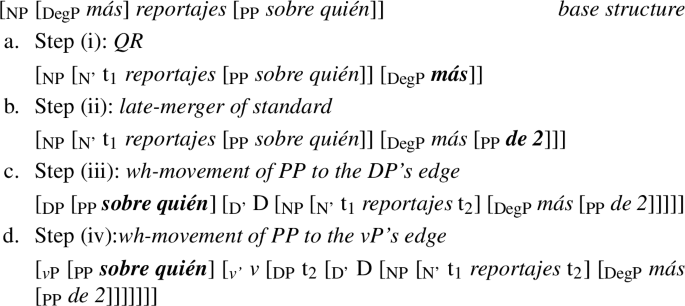
In this subsection, I have shown that an analysis that relies on overt extraposition from the complement position of más to a DP-internal specifier is not empirically supported. Overt extraposition within a DP must block wh-movement out of that DP. However, the prediction is not borne out for the cases of de-comparatives under discussion. Instead, I have argued that an analysis relying on QR of más+ late-merge of the standard is able to predict data presented and conforms to the generalization in (100).
II. Linearization
The final issue for an account suggested by the reviewer in which the de-standard undergoes overt extraposition DP-internally is related to linearization. Linearization flattens syntactic structure and assigns linear order to the content of the relevant spell-out domain. According to Fox and Pesetsky (2005a,b), once the linearization information has been established by generating an ordering statement (e.g. X < Y, where < means ‘linearly precedes’), that information is never deleted. In the case of rightward extraposition, the operation is constrained by the Right Edge Extraposition Constraint (Nissenbaum 2000b; Jenks 2011; Overfelt 2015; Davis 2023) formulated in (106) from Davis (2023), and schematized in (107):
-
(106)
Only an XP that appears at the right linear edge of a given DP is available for rightward extraposition from that DP. If other material in that DP appears to the right of that XP, XP cannot extrapose.
-
(107)
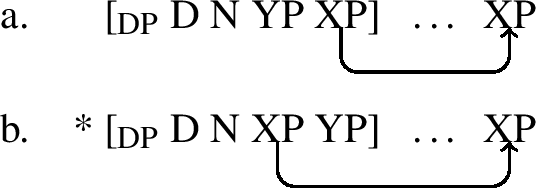
The reason why (107b) is ruled out is due to a contradictory ordering statement: when the DP is sent to PF, XP is linearized to the left of YP, e.g. XP < YP, but subsequent movement of XP over YP creates the order YP < XP. Given that order preservation has been violated and there are two conflicting ordering statements (e.g. XP < YP and YP < XP), the computation crashes.
A similar explanation can be given if the de-standard is base generated in the complement position of más within the DegP, and then it undergoes overt rightward extraposition. First, PF must establish the ordering statement of the DegP itself, and then that of the whole DP. DegP-internally, más must linearly precede its complement as in (108). At the DP level, the conflicting order in (109) is established:
-
(108)
[DegP más PP] → más < PP
-
(109)

The DegP, and everything it dominates, linearly precedes the head N. However, extraposing the DegP internal PP entails that the PP both precedes and follows the N creating a clash.
On the contrary, the hybrid QR+late merger account proposed in the paper does not have to deal with linearization problems: QR of más happens first, followed by late merger of the standard. At PF, and according the phonological theory of QR assumed all along, the relevant copy of the quantifier is the low one, in Spec,NP, while the highest copy is deleted. Due to late-merger of the standard, there is no copy of the PP in the base position of the DegP. Therefore, its surface position, to the right of all DP internal material does not create a lineraization clash, e.g. (110):
-
(110)

All in all, an account based solely on extraposition is not empirically supported; and unless there is evidence to believe otherwise, one should be skeptical about approaches that do not link the scope of más and the de-PP. Furthermore, the problems that such accounts would create can be circumvented under the QR+late merger analysis.
Rights and permissions
Open Access This article is licensed under a Creative Commons Attribution 4.0 International License, which permits use, sharing, adaptation, distribution and reproduction in any medium or format, as long as you give appropriate credit to the original author(s) and the source, provide a link to the Creative Commons licence, and indicate if changes were made. The images or other third party material in this article are included in the article’s Creative Commons licence, unless indicated otherwise in a credit line to the material. If material is not included in the article’s Creative Commons licence and your intended use is not permitted by statutory regulation or exceeds the permitted use, you will need to obtain permission directly from the copyright holder. To view a copy of this licence, visit http://creativecommons.org/licenses/by/4.0/.
About this article
Cite this article
Toquero-Pérez, L.M. There is only one más: Spanish que/de comparative alternation. Nat Lang Linguist Theory (2023). https://doi.org/10.1007/s11049-023-09590-5
Received:
Accepted:
Published:
DOI: https://doi.org/10.1007/s11049-023-09590-5








































































































 and twenty books with NP-deletion in the first conjunct. However, in Biblical Welsh and Scottish Gaelic, NP deletion occurs in the second conjunct instead. In addition, in the two types of languages mentioned, both NPs can be deleted (e.g. two hundred
and twenty books with NP-deletion in the first conjunct. However, in Biblical Welsh and Scottish Gaelic, NP deletion occurs in the second conjunct instead. In addition, in the two types of languages mentioned, both NPs can be deleted (e.g. two hundred  and twenty
and twenty  ) but they cannot be both overt (e.g. * two hundred books and twenty books). Spanish comparative numerals are a mixture of the two types: either (or both) NP(s) can undergo deletion.
) but they cannot be both overt (e.g. * two hundred books and twenty books). Spanish comparative numerals are a mixture of the two types: either (or both) NP(s) can undergo deletion.















